

Me and My Six Imaginary Friends: The Practicalities of Yacht Layouts

Smooth Sailing: Pros and Cons of a SWATH Vessel

- 8200 Fluids
- 8450 Fluid Loads
- 8600 Arrangements
- aker arctic trimaran
- deadweight coefficient
- littoral combat ship
- trimaran icebreaker
- triton trimaran

Why You Want a Trimaran: Pros and Cons of a Trimaran
Three hulls are better than one! That would be the adage of the trimaran. It consists of one central hull with two smaller side hulls, called amas. The average person conceives of the trimaran as something even more extreme than catamarans. Lighter weight, higher speed, more specialized. The opposite is actually true; trimarans fill an excellent transition role between monohulls and catamaran. Recognize the potential applications by understanding the strengths and weakness of the trimaran hullform.
1.0 What Makes a Trimaran
When you seek trimarans, envision stability. A conventional monohull must balance conflicting needs of resistance and stability. You want a narrow skinny hull to reduce resistance (and fuel consumption). But you need a wide hull to maintain vessel stability and keep the ship upright. The trimaran separates these two design requirements.
In a trimaran, the central hull provides most of the ship buoyancy (90-95% usually). It does this with a long, narrow hull. And then the outer hulls, called amas, provide the stability. This arrangement allows incredible flexibility in the hull design. Due to the wide separation between hulls, it requires very little buoyancy in the amas to keep the trimaran stable. That is why many trimarans barely have their amas in the water. Compare the relative size of the amas vs the main hull in Figure 1‑1. The amas are just there for stability.

2.0 Advantages
The trimaran offers several capabilities to bridge the gap between monohulls and catamarans:
- Excellent for high speed
- Moderate weight carrying capacity
- Good seakeeping capability
- Larger available deck area
- Moderate space below the main deck
Another advantage is the design of the cross deck (Figure 2‑1) between the main hull and amas. On a catamaran, this cross deck bridges a large empty gap. Large gaps add complexity to the engineering and require stronger structures. We don’t like that. Stronger structures mean more weight and higher costs. But the trimaran’s cross deck is much smaller. It requires less of a gap between hulls, and it does not extend for the entire ship length. Longitudinal bending is less of a concern for the cross deck. This greatly simplifies the design of that cross deck, giving us many advantages:
- Heavier loads can be carried on the cross deck
- Less structural weight required for the cross deck
- Deadweight coefficients closer to monohulls

The long length of the center hull also offers great advantages for seakeeping. This length greatly reduces pitch motions in a wave, and the narrow center hull reduces chances of slamming. To improve things even more, the side amas reduce roll motions. They add stiffness to prevent large roll motions. But they also act to reduce roll accelerations. All together, trimarans make for gentle seakeeping.
The trimaran offers major advantages for damage survival. The side amas provide excellent protection to the center hull, which military designers find especially useful. But the cross deck also helps with damage survival by containing massive reserve buoyancy. Imagine a damage situation where the ship sinks down to its cross deck. On a monohull, that would be game over. But on a trimaran, the cross deck suddenly becomes a barge, easily supporting the entire ship weight. This reserve buoyancy provides extra peace of mind in yachting applications.
Speaking of peace of mind, let’s talk about a sudden loss of stability. In catamarans, you lose stability once a single ama completely leaves the water. Push a catamaran past that point, and stability is a losing battle. A fact that scares many vessel operators. Trimarans do not have this problem. They get stability mainly from submerging the amas. The center hull always stays in the water, and the leeward ama continues to submerge. This creates a predictable increase in righting moment. In normal cases, trimarans never experience the sudden loss of stability.
3.0 Disadvantages
The biggest disadvantage for trimarans is lack of experience. There are few trimarans in military applications, and even less in commercial use. That lack of exposure instills wariness in many operators. I appreciate caution, but don’t let that stop you from realizing the benefits of a trimaran.
Trimarans do have a few genuine detractors. Due to their complexity, they require some extra design effort. The cross deck introduces a few extra ways to twist and bend the ship, and the engineers must check each of these extra scenarios. Finite Element Analysis (FEA) is the ideal tool for this.
Don’t worry about the FEA bill. You should expect a slight increase, but nothing huge. FEA was already a part of the design process for normal monohulls. Most ship designs already require FEA to consider global hull bending. That means the hard part is already done. Your engineer already had to build an FEA model of the hull. With minimal effort, engineers can expand that model to account for the additional design scenarios of a trimaran.
Cost definitely factors into trimaran construction. The cross deck and extra hulls do add extra steel to the design. You have to pay for that extra steel as part of the build cost. (Figure 3‑1) But don’t assume this drastically increases the total build cost. Adding extra structure is far less expensive than adding extra machinery and power.
Consider the alternative to a trimaran: an equivalent monohull. For the monohull, we strip off the side amas and widen the center hull to maintain ship stability. But bad news. A wider hull requires a larger engine, and associated support machinery. In general, the machinery accounts for approximately 50% of the total build cost. The structure is only around 25-30% of the build cost. [3] Adding larger machinery costs twice as much as adding extra structure.

4.0 Applications
You see trimarans most often in high speed vessels and the occasional military vessel.
- Car ferries
- Military ships
One of the first experimental military trimarans was the Triton, a steel vessel with a displacement exceeding 1000 MT. [3] (Figure 4‑1) These are not little vessels.

Don’t think of trimarans as an expensive hullform. The prevalence of trimarans with expensive ships is mostly a coincidence. Imagine if you wanted a high speed ship. First step is pick a trimaran hullform. But for high speed, you also build it out of aluminum and load it with powerful engines. Those are all high priced decisions that get imposed on the trimaran hullform. The hull shape does not drive the price tag, and trimarans are not limited to high speed.
Aker Arctic even investigated using trimarans as an icebreaking tug. (Figure 4‑2) Aker found the trimaran configuration especially useful for cutting wide channels through the ice with less power. Trimarans are just a hull configuration. How you use the hull is up to you.

5.0 Conclusion
Don’t let the previous trimarans limit your imagination. The trimaran hullform bridges the gap between monohulls and catamarans. It offers some advantages of both deadweight capability and larger deck area. Primarily, trimarans deliver ship stability in a very power efficient package. What uses can you imagine with that flexibility?
6.0 References
Related posts.

How to Design a Ship

Stability Letters Explained

Free Surface Moment

Practical Stability Test: Naval Architect’s Guide
BoatNews.com
Choosing a trimaran sailboat, advantages and explanation of the reasons for this purchase
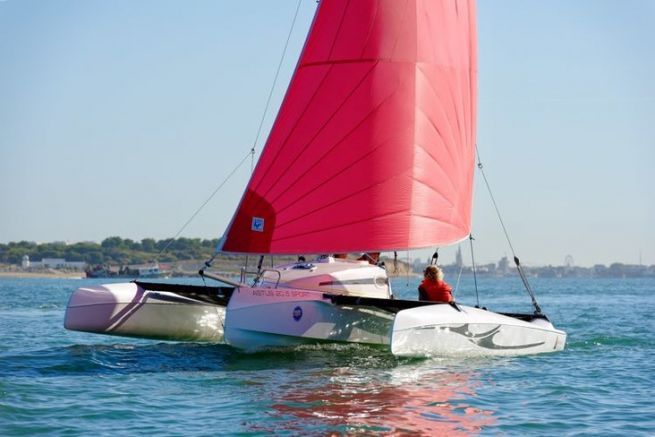
The purchase of a boat is an important act. Jean-Hubert Pommois, creator of the Astus Boat brand explains the advantages of sailing a trimaran and the keys to not forgetting anything when buying your boat.
What are the key points on a trimaran?
A trimaran is distinguished by three characteristics: Speed , Stability and lightness.
Speed increases navigational distances. The faster we go, the farther we go. By lengthening the stride, by offering speeds well in excess of a monohull, the trimaran enables you to envisage more distant stages.
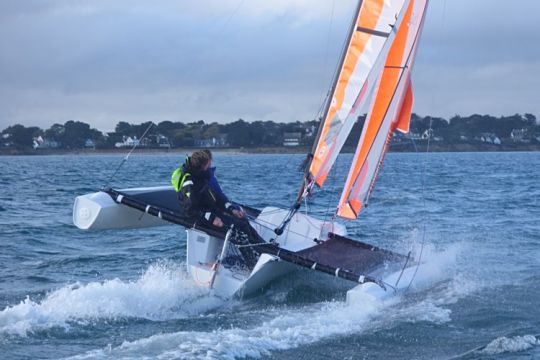
A trimaran is stable, she doesn't heel. This stability is very reassuring, especially in the context of a family programme. This comfort at sea and the surface area of the platform enlarged by the trampolines which go from one float to the other are a security for the whole crew . This stability and behaviour at sea also limits seasickness . Often crew members who are ill on monohulls are not ill on trimarans.
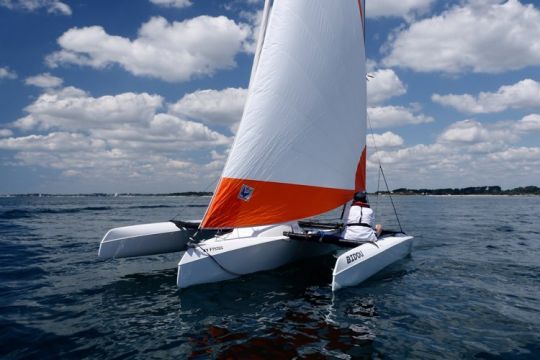
With the absence of ballast, a trimaran is light. This weight will be an asset for transport . With the addition of the folding arms as the Astus have, these yachts can be masted and launched by one person alone in a few minutes. This autonomy of use and the possibility of towing the sailboat with a normal vehicle opens up a new world. Even remote bodies of water become accessible.
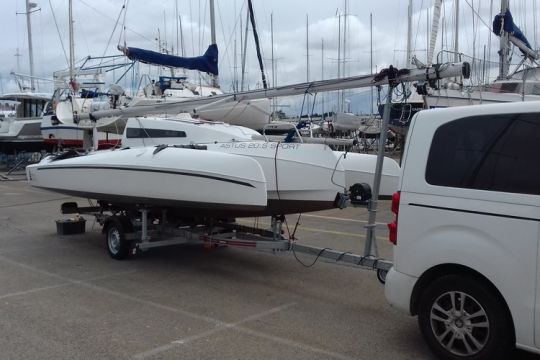
What are the uses for a trimaran?
Owners of Astus trimarans are above all looking for a yacht that is easy to manoeuvre. Even if they don't sail single-handed, they are often accompanied by a crew of unamarined novices (family, children...). To do this, all the manoeuvres return to the cockpit accessible from the helm station: sheets, halyards and daggerboard manoeuvres.
Small and easy to handle, these trimarans are often used for sailing close to the coast, on low rocks. They must therefore be easy to handle. To do this, the centreboard in the central hull is pivoting, as is the rudder blade. For safety, a fuse system prevents breakage. This is all the more true as speed often creates damage .
The trimaran's programme is twofold. The owners use it for day coastal cruising with the family or as a raid during the summer season. But with the same boat, they also do regattas with their friends in the off-season. This duality of use is very much appreciated.
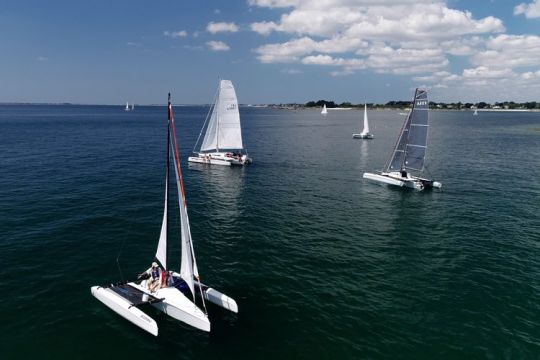
What should not be forgotten when buying?
The shipyard that delivers the boat offers a list of options to which some accessories must be added: a trailer, an outboard motor and a dinghy (often paddle or kayak ). You will also need to think about insurance. The shipyard is not a prescriber, but it helps customers to find the best price/protection compromise for their clients. Having a good knowledge of our boats, the shipyard can also help in the choice of safety equipment to adapt it to the crew and the practice. It is this assistance that is important for the owner to make the best use of his new toy .
- Articles and Guides
Catamaran vs Trimaran: Choosing the Perfect Multihull Vessel
26th mar 2023 by toi williams.

The debate over whether catamarans or trimarans are better boats has been going on for a long time without resolution, but the reason is understandable. The truth is that despite their many similarities, catamarans and trimarans have distinct characteristics that set them apart from each other, so each type of vessel offers a distinct boating experience. The catamaran vs. trimaran debate largely boils down to personal preference and how you intend to use the boat. Here are some of the things you need to consider when choosing between a catamaran and a trimaran.
What Is a Catamaran?
A catamaran is a multi-hulled boat that has two twin hulls connected by a structure supported by a wide beam. Catamarans come in a wide variety of sizes, ranging from small rowing boats to large boats that are big enough to be used as car ferries. The structure connecting the two hulls can be anything from a simple frame with webbing to a superstructure that includes cabin and/or cargo space. Most of the recreational catamarans for sale are designed to hold two to 20 passengers.

What Is a Trimaran?
A trimaran is also a multi-hulled boat, but it has three hulls instead of two like the catamaran. The middle (main) hull is larger than the two small outer hulls attached to it. These hulls are connected by a lateral beam, wing, or some other form of superstructure, depending on the model. These types of boats also come in a wide variety of sizes, ranging from recreational yachts to ferries.

Advantages of Catamaran vs. Trimaran
The advantages of catamarans vs. trimarans are mainly based on comfort. Catamarans are spacious boats, known for their large living quarters with plenty of room on board for hosting gatherings and parties. Their popularity has enticed many boat builders to create increasingly luxurious designs on larger and larger boats. The catamaran also has a more classic style that appeals to those who want a boat with a simple, sleek shape. Catamarans are best suited for boating in calm seas, lagoons, and shallow waters.
Advantages of Trimaran vs. Catamaran
The advantages of trimarans vs. catamarans mainly come down to speed. Trimarans are among the speediest boats available, offering lightning-fast speeds on open waters. Many recent winners of notable boating competitions have been won by boaters piloting trimarans. These boats also perform well when heading upwind and are remarkably stable with their three-hulled design. The anchoring gear is installed on the main hull and is easy to deploy.
Trimaran vs. Catamaran Speed
In the trimaran vs. catamaran speed debate, the trimaran is the clear winner. For long offshore races, trimarans have become the preferred vessels, and boaters piloting trimarans have won the Jules Verne Trophy in every race held since 2010. This is because of their unique design, which has speed and safety qualities that provide significant benefits for boaters.
The trimaran's third hull makes the boat considerably faster than any other hull form due to the correlation between the boat’s waterline length and its speed. Having more hull distance in the water lets the boat reach higher speeds. Trimarans can also be pushed harder and are more forgiving than other boat styles in racing environments.
That doesn't mean that catamarans are slow. Some styles of catamarans are capable of breaking world records when the boating conditions are right. On downwind runs, a racing catamaran may be quicker than a trimaran, but for overall speed in various conditions, the trimaran comes out on top.
Catamaran vs. Trimaran Performance
In the catamaran vs. trimaran performance debate, both sides have their advantages. A catamaran is easier to handle and maneuver with the boater having to handle the lines and halyards less often. However, this ease comes at the expense of speed, with cruising catamarans generally traveling slower than comparable trimarans.
Trimarans are more versatile in their performance, and they perform better than a catamaran when traveling against the current or the wind. Trimarans can be used in nearly all weather conditions, are less vulnerable to drifting, and have less roll motion than a catamaran. However, handling a trimaran requires more work than handling a catamaran, which can be exhausting over long periods of sailing.
Trimaran vs. Catamaran Efficiency
When comparing trimaran vs. catamaran efficiency, the differences are minimal. Multi-hulled boats are more fuel-efficient than comparable mono-hulled boats due to their hull forms and their lighter weights. Multi-hulled boats also tend to have smaller displacement and shallower drafts than other boat styles.
The biggest difference in trimaran vs. catamaran efficiency is that catamarans nearly always have twin engines while trimarans generally run with one engine. A trimaran also has less hydrodynamic resistance than a catamaran because it spreads out the displacement across three hulls instead of two. This allows each hull to be narrower and more streamlined.

Catamaran vs. Trimaran Stability
The stability of multi-hulled boats is one of their biggest advantages over mono-hulled vessels. Multi-hulled boats benefit greatly from their wider stance on the water, and their wide beams and floats offer higher stability than a ballasted keel. Multi-hulled boats are also more buoyant because their floats help prevent immersion. When comparing catamaran vs. trimaran stability, the better boat will depend on the conditions on the water.
A catamaran's geometrically stabilized design reduces both heeling and wave-induced motion, providing a stable platform underway and at anchor. However, the catamaran's design is not as suitable for navigating heavy seas as the trimaran's build. The trimaran's three hulls provide excellent stability even in rough waves, but this can also make a trimaran less comfortable than a catamaran when the water is calm.
Catamaran vs. Trimaran Safety
Both catamarans and trimarans are considered to be safer on the water than mono-hulled boats. A catamaran has superior resilience and roll inertia that makes capsizing extremely unlikely. Its speed, steadiness, and ease of motion due to a lack of ballast also contribute to increased safety.
Trimarans are considered the safest multi-hulled boats because their three-hulled design makes them almost unsinkable. Many also have a core made of high buoyancy foam, helping them stay afloat even in the most brutal storms. Weight centering and a complete anti-drift scheme also make the boat safer for everyone aboard.
Trimaran vs. Catamaran Maintenance
Comparing trimaran vs. catamaran maintenance costs shows that many of the costs will be very similar for both types of boats. These costs include yearly boat service and repairs, annual haul-outs, and insurance coverage but exclude major upgrades. You will also have to budget for dockage, winterization, and storage for each year if you don't intend to use the boat year-round.
Boaters are advised to budget between 5% and 10% of the boat's value for annual maintenance costs if their boat is less than five years old and a little more if the boat is older than that. Different maintenance jobs can be charged in different ways. Sometimes, the charges are based on the length of the boat while other charges are based on the number of hours worked.

Catamaran vs. Trimaran Cost
If you are looking for an affordable seafaring vessel, catamarans and trimaran are both good choices. There are many reasonably priced catamarans and trimarans suited for families as well as other models that provide more luxury for an additional cost. The materials that the manufacturer used to build the boat and the electronics included will also impact the price of the boat.
With so many different factors impacting the cost of different boats, you should choose the best vessel for you based on the features you want as well as your budget. Doing some research using the information on Rightboat's listings will help you find the right combination of quality and affordability you are looking for. Because we offer both new and used boats, nearly any boater will be able to find a boat in our listings that fits their needs.
Choosing between a catamaran and a trimaran may seem simple at first, but the different sizes, styles, and amenities offered can make the choice much more complicated than you would think. If you prefer comfort and ample space while cruising, a catamaran may be the better choice. However, if you like speeding across the water and enjoy the thrill of racing, then a trimaran may be your best option.
Whichever boat you decide to purchase should fit your specific circumstances and requirements. Start the decision-making process by deciding what the primary use for your new boat will be. Will it be used more for family cruising or sport fishing? What bodies of water will you be boating in? Are you planning on staying close to shore or taking the boat into deeper waters? All these factors will impact whether you should choose a catamaran or a trimaran.
With Rightboat's listings, you can learn about the features of the latest catamaran and trimaran models and see what you can expect to pay for the boats you are considering. You can sort through our listings by price, age of the boat, length of the boat, or listing date and then narrow down the results of a search using the rest of our filtering tools. If you are interested in buying a new or used catamaran or trimaran, take a look at our listings, and see what we have to offer today!
Related article: Ketch vs Yawl
Written By: Toi Williams
More from: Toi Williams
Related Articles and Guides
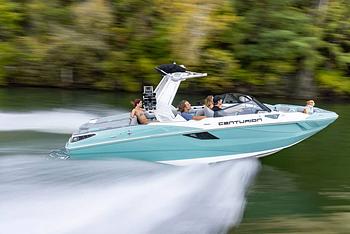
20th Mar 2024
Best Wakesurf Boat Brands
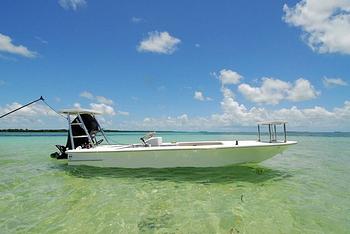
4th Mar 2024
The Best Flats Boats Brands, Special Boats for Skinny Waters
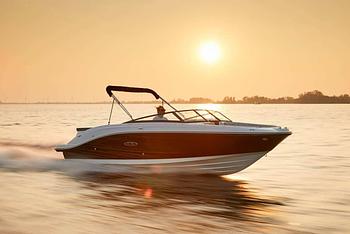
21st Feb 2024
Best Lake Boat Brands for Fishing, Cruising, and Watersports

15th Feb 2024
Best Aluminum Fishing Boat Brands: Tougher, Lighter and More Affordable
- Explore Rightboat
- Boats for Sale
- Boating Articles
- Buyers Guide
- About RightBoat
- Sell Your Boat
- Boat Selling Advice
Enter your email to keep up to date with the latest news
Join for free
Sign up now for free and discover how easy it is to keep up to date with THE latest boats for sale. Find your right boat, and tailor your voyage to finding your next boat.
Benefits of becoming a member:
- Set up tailored alerts
- Personalise your experience
- Download full specifications and broker details
- Keep tabs on your favourite boats
Are you a broker? Join as a Broker
Rightboat - join for free.
Do you have an account already? Login
Save this search
Save your search and receive new boats in your email..
You can unsubscribe from your alerts whenever you like. By pressing the button you accept the Legal Terms and conditions
Newest Posts
- Cleaning and Waxing the Hull: A Comprehensive Guide
- Everything You Need to Know About Upholstery and Canvas Services
- Documentation Requirements for Boat Transport
- Installing New Upholstery: A Step-by-Step Guide
- Inflatables and tenders
- Ribs and rigid inflatables
- Inflatable sailboats
- Inflatable kayaks and canoes
- The Art of Boat Building: A Guide from an Expert
- The Ins and Outs of Boat Shipping Companies
- Racing sailboats
- Houseboats and yachts
- Motor yachts
- Sailing yachts
- Luxury houseboats
- Personal watercrafts
- Ski and wakeboard boats
- Fishing boats
- Cabin cruisers
- Pontoon boats
- Choosing a boat type
- Identifying your needs
- Power or sail?
- Budget considerations
- Types of propulsion systems
- Selecting a dealer or broker
- Checking references
- Negotiating pricing and financing
- Researching boats
- Comparison shopping
- Reviews and ratings
- Test drives and sea trials
- Design and planning services
- Hull design and engineering
- Cabin design and layout
- Materials and construction services
- Woodworking and joinery services
- Metal fabrication services
- Finishing services
- Painting and varnishing services
- Upholstery and canvas services
- Electrical system repair services
- Wiring and rewiring services
- Electrical system diagnostics and troubleshooting
- Engine repair and maintenance services
- Inboard engine repair and maintenance
- Outboard engine repair and maintenance
- Structural repairs and maintenance services
- Deck repairs and maintenance services
- Hull repairs and maintenance services
- Transport options for boats
- Shipping a boat by ocean freight or air freight
- Towing a boat by trailer or truck
- Use A1 Auto Transport Boat Transport Services And Claim 15% Off
- Logistics for boat transport
- Documentation requirements for boat transport
- Insurance requirements for boat transport
- Boat unloading services
- Unloading boats from air freight containers
- Unloading boats from ocean freight containers
- Replacement parts
- Replacement outboard motors
- Replacement inboard motors
- Replacement electrical components
- Preventive maintenance services
- Cleaning and waxing the hull
- Cleaning and polishing the topsides
- Inspecting the rigging
- Repair services
- Engine repairs
- Electrical system repairs
- Hull repairs
- Assessing the condition of the boat
- Testing the electrical systems
- Identifying damage to the hull
- Inspecting the riggin
- Restoration work
- Rewiring the electrical systems
- Refinishing decks and topsides
- Replacing rotten woodwork
- Finishing touches
- Painting the hull
- Installing new upholstery
- Varnishing woodwork
- Trimarans - Exploring the Unique Three-Hulled Sailboat
Have you ever heard of a trimaran? It's a unique type of sailboat with three hulls, and it's quickly becoming one of the most popular sailing vessels out there. Trimarans offer a special kind of sailing experience, combining the stability of a catamaran with the speed and agility of a monohull sailboat. In this article, we'll explore the history, design, and uses of trimarans, and discover why they're quickly becoming the go-to choice for sailing enthusiasts. If you're interested in purchasing a trimaran, you may be wondering about the Florida boat shipping cost . The history of Trimaran sailboats dates back to the early 19th century when they were first developed by the British Royal Navy. Trimarans are unique in that they have three hulls instead of the traditional two-hulled design of most sailboats.
They offer a number of advantages over other boat types, including increased stability in rough waters, faster speeds than monohulls, and a greater range of motion for the captain. However, trimarans come with a number of drawbacks, such as their higher cost and increased vulnerability to damage. One of the most famous trimarans is the US-built 'Defiance', which was designed by naval architect Reuel Parker and first launched in 1887. Defiance was one of the earliest trimarans to be used for recreational sailing, as well as for competitive racing. Defiance remained in service until the early 20th century and was used to set several speed records during its time.
Types of Trimarans
Trimaran construction, sails and rigging, safety considerations, the disadvantages of trimarans.
If one of the hulls is damaged, the entire boat can become unstable and dangerous. This makes them more risky to sail in rough conditions than monohulls. Trimarans are also more complex than monohulls in terms of rigging and sailing. They require more experience and skill to operate, making them better suited for experienced sailors. Finally, trimarans require more crew members due to their larger size and additional sails. Overall, trimarans can be an excellent choice for experienced sailors looking for a unique experience on the water.
The Advantages of Trimarans
This makes them particularly attractive for competitive racing, as they can outpace monohulls in most conditions. Trimarans are also much more maneuverable than other boats, allowing them to quickly turn and change direction. In addition, trimarans offer increased space aboard compared to monohulls. This makes them an excellent choice for recreational sailing, as they provide plenty of room for multiple people and their gear.
Cruising Trimarans
Construction and rigging.
This allows for a lighter and more maneuverable sailing experience. When it comes to rigging and sails, trimarans use the same basic principles as other sailboats. The sails used on trimarans are mainly spinnakers, jibs, mainsails, gennakers, and staysails. In addition, a trimaran needs additional rigging and gear such as halyards, sheets, and running rigging.
Trimarans can also be equipped with additional equipment such as anchors, fenders, and radios. This can help improve safety and performance while sailing. In conclusion, trimarans offer a unique sailing experience due to their three-hull design. They require the same basic rigging and sails as other sailboats, but also have additional needs for extra equipment.
With the right rigging and gear, trimarans can be used for recreational sailing as well as competitive racing events. Trimarans are a unique and exciting type of sailboat that offers some distinct advantages over monohulls. They have three hulls instead of two, and provide greater stability and agility than other boat types. Trimarans are used for both recreational sailing and competitive events, and require more crew members than monohulls.
The construction and rigging of trimarans is also more complex than other boat types, and safety considerations should always be kept in mind. Therefore, if you're looking for a unique sailing experience, a trimaran could be the perfect choice. In conclusion, trimarans offer an exciting and unique sailing experience, with many advantages over traditional monohulls. They are suitable for both recreational sailing and competitive events, but require additional crew members and safety considerations. If you're looking for a unique sailing experience, trimarans could be the perfect choice.
- Everything You Need to Know About Bowriders
- Rewiring Electrical Systems for Boat Restoration
- Metal Fabrication Services - A Comprehensive Look
- Everything You Need to Know About Fishing Boats
- Towing a Boat by Trailer or Truck
- Cleaning and Polishing the Topsides
- Motor Yachts: A Comprehensive Look at the Luxury Boating Option
- Sailing Yachts: An Overview
- Diagnosing and Troubleshooting Electrical Systems
- Boat Selection: Budget Considerations
- Deck Repairs and Maintenance Services: Everything You Need to Know
- Inflatable Kayaks and Canoes: Everything You Need to Know
- Reviews and Ratings: What You Need to Know
- Catamarans: Exploring the Versatile Boat Type
- Refinishing Decks and Topsides: A Restoration Work Guide
- Everything You Need to Know About Racing Sailboats
- Hull Repairs and Maintenance Services: Everything You Need to Know
- Identifying Damage to the Hull - A Comprehensive Guide
- Identifying Your Needs: Choosing the Right Boat Type
- Inspecting the Rigging: A Comprehensive Guide
- Replacement Inboard Motors: What You Need to Know
- Types of Propulsion Systems: An Overview
- Wiring and Rewiring Services for Boats
- Insurance Requirements for Boat Transport
- How to Repair Your Boat Hull
- Test Drives and Sea Trials: A Comprehensive Overview
- Exploring Hull Design and Engineering
- Cabin Cruisers: An In-depth Look at Powerboats
- Inboard Engine Repair and Maintenance
- Outboard Engine Repair and Maintenance: Everything You Need to Know
- Varnishing Woodwork: A Comprehensive Guide
Shipping a Boat - Choosing Between Ocean Freight and Air Freight
- Replacement Electrical Components: A Comprehensive Overview
- Personal Watercrafts: A Comprehensive Overview
- Daysailers: An Informative Overview
- Negotiating Pricing and Financing for Boat Selection
- Unloading Boats from Air Freight Containers
- Unloading Boats From Ocean Freight Containers
Inspecting the Rigging: Assessing the Condition of the Boat
- Comparing Boats: A Comprehensive Overview
- Pontoon Boats: Everything You Need to Know
- Cabin Design and Layout Explained
- A Comprehensive Overview of Engine Repairs
- Replacement Outboard Motors: Everything You Need to Know
- Discovering the World of Luxury Houseboats
- Painting the Hull: A Comprehensive Overview of All Aspects
- Testing the Electrical Systems: An Overview
- Ribs and Rigid Inflatables: What You Need to Know
Cruisers: An In-Depth Look at One of the Most Popular Sailboat Types
- Understanding the Differences between Power and Sail Boats
- Everything You Need to Know About Ski and Wakeboard Boats
- Woodworking and Joinery Services: An Overview
- Inflatable Sailboats: Everything You Need to Know
- How to Replace Rotten Woodwork
- Checking References for Boat Selection and Broker Selection
- A Comprehensive Overview of Electrical System Repairs for Boats
- Painting and Varnishing Services: A Comprehensive Overview
- Everything You Need To Know About Catamarans
New Articles
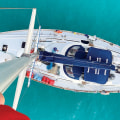
Which cookies do you want to accept?

Catamaran Vs Trimaran

Last Updated by
Gabriel Hannon
August 30, 2022
As boatbuilders make faster and more luxurious multi-hulls for cruising and racing, it is time to settle the debate: Catamarans vs. Trimarans.
Catamarans and trimarans have distinct characteristics regarding comfort, sailing performance, safety, and personal preference. The dual- or tri-hull designs both confer significant advantages over traditional monohulls and each fill an amazing niche in the sailing world.
Though both are based on traditional Austronesian outrigger canoes, the dual-hulled catamarans and tri-hulled trimarans have distinct design goals that make them ideal for very different purposes, and it is important to take into account your goals when trying to decide which to sail! We’re going to discuss both types as they rate across performance, safety, comfort, and possible uses. There is no one solution to this age-old problem, but we can help you understand which design is best for you!
From boatbuilder releases to the history of their development, it is important to access lots of sources when trying to make this decision. As a performance sailor, my heart is always in the speed and upwind abilities of the trimaran, but modern catamarans are dynamic and incredibly comfortable. Still, in my opinion, anything that gets you on the water is a great boat, so let’s find the right one for you!
Table of contents
Sailing Performance and Safety
While most traditional boats over 20 feet are monohulled keelboats, there are major limitations to the type of sailing you can do with a monohull. First of all, monohulls depend on their keel to keep them upright, which is effective, but the force of the wind almost always causes the boat to heel to leeward by angles of up to 25° under reasonable cruising conditions, which can be quite uncomfortable for the crew! This design, which relies on giant lead ballast in a deep-set keel, is vulnerable to capsizes and, in drastic cases, sinking.
Additionally, the single-hull only provides so much volume for accommodation and storage, while the more horizontal layout of the multi-hulls can increase cockpit and cabin sizes substantially. Beyond that, both types of multi-hull can experience higher speeds at a given hull length than monohulls.
So how do cats and tris compare to each other? Well,
Catamarans: Stability and Ease
With their dual ‘pontoons,’ Catamarans make use of their floats to always remain on a flat and consistent angle of heel, rarely sailing under more than 10° of heel. This distribution of floatation also makes it nigh on impossible for them to capsize, though the distance between the hulls can make it a problem in the rare cases that they do flip. They do suffer a bit from not having any wetted surface underneath the center of effort, causing them to slide sideways while sailing upwind and making it difficult for them to beat tight angles to the breeze. While they make up for this with speed on the reach and downwind, catamarans are an inferior option for trying to make progress upwind in heavy sea and wind conditions.
These tradeoffs do come with some advantages. Unlike monohulls, catamarans have very shallow drafts, allowing cruisers to sail close to shore without concern, and their common dual-motor design allows them to maneuver incredibly well in tight spaces with a built-in backup for single-engine failure. They heel minimally because of the horizontal distribution of weight, and this means that they are incredibly stable and comfortable while underway or at anchor. In addition, their sail plans and maneuverability characteristics do make them easier to sail with a smaller crew, requiring fewer highly experienced sailors in your party.
Trimaran: Speed and Safety
While traditionalists have finally come around on the aesthetics of the dual-hulled catamaran, the tri-hulled lines of trimarans can still be a bit of a shock to viewers. They combine the vertical stability and upwind capabilities of a monohull with the speed and lateral stability of a catamaran.
When it comes to performance sailing, modern trimarans are well ahead of any other hull design. Due to the relationship between speed and the ‘waterline length’ of a boat, i.e. that more hull length in the water leads to higher speeds, the third hull actually makes trimarans drastically faster than any other hull shape at a given length. Most current speed records, including those for circumnavigation, instantaneous velocity, and single-day distance, are held by Trimarans. In competition, the 2013 America’s Cup is a perfect example of the superiority of Trimarans over Catamarans in terms of speed, as the challenging Trimaran from Golden Gate Yacht Club handily beat the defending Spanish Catamaran in a best-of-three series. With their signature central hull, they can make better upwind progress without drifting and often heel even less than contemporary catamarans.
Further, trimarans far outclass both catamarans and monohulls in terms of safety. The central hull gives the trimaran that signature central righting moment from monohulls, while its winged pontoons provide it the lateral balance that makes catamarans so safe themselves. Combined, this gives a modern trimaran a righting moment of 27°, which is almost impossible to reach in any breeze condition because of the pontoons. For a comparison, modern cats can only maintain 12° of heel before flipping, which is not entirely uncommon in heavy seas.
Therefore, in a purely technical sense, trimarans are safer, speedier, and more rewarding. Still, to reap these benefits you often need to be a little more prepared to engage with the more advanced aspects of sailing, and the tri-hull design does make some sacrifices in other areas.
Though performance is an important metric for all sailboats, every added knot of speed or degree of heel comes at a price of comfort, and it is here that we need to consider the full implications of that cost for both cats and tris.
Catamaran: The Ideal Platform
When it comes to comfort, space, and luxury, it is hard to bet against the catamaran. Because of the geometry of the dual deep hulls and built-up central platform, catamarans offer the ideal vessel for a large crew, a party yacht, or a comfortable getaway vessel. They heel minimally, are highly stable at anchor, and the central platform can be carefully built to maximize the area between the wings. Most catamarans can offer the living space and horizontal area of much larger monohulls, making it the ideal choice for a pleasure cruise.
Trimaran: The Cost of Speed
For all their advantages in terms of performance, the hardware required for the central hull subtracts substantially from the accommodations that are available for a cat of the same size. New trimarans, like the Neel 51 which made waves back in 2017, are pushing back against this perceived comfort gap, the large central hull with the two performance-oriented wings does make it harder for tris to haul the same amount of weight and provide comparable space as most cats.
Preferences
The beauty of modern sailboats is that design advances in both catamarans and trimarans make it possible for all sailors to find the exact right boat for them. Speed demons who want to sail tight to the wind and feel that rush may find themselves enticed by the capabilities of the newest Trimarans, while cruisers looking to get the biggest space for the length are still thrilled by how fast and stable modern Catamarans are off the breeze. While no one would complain about being invited to a cruise on a new Trimaran, you can certainly fit more of your friends in the spacious decks of a Cat.
Both multi-hull styles excel at maneuvering in small spaces and shallow waters, perfect for island hopping or inland sailing. Their wide platforms, which can run a slightly higher cost at marinas than comparable monohulls, enable stability without sacrificing performance. Both are regarded as incredibly safe in nearly all conditions, though Trimarans do have the slight edge in truly nasty weather.
In the end, it all comes down to how you want to sail and what is going to make a good trip successful! For those looking for a leisurely cruise with a minimum of work and a maximum of space, find the most spacious catamaran you can, and don’t worry about missing out on speed as you’ll more than hold your own off the breeze. If you’re excited to go fast no matter what direction the wind is coming from, with the knowledge that you’re nigh on unsinkable, a performance trimaran is the way to go!
Happy Sailing!
Related Articles
I have been sailing since I was 7 years old. Since then I've been a US sailing certified instructor for over 8 years, raced at every level of one-design and college sailing in fleet, team, and match racing, and love sharing my knowledge of sailing with others!
by this author
Learn About Sailboats
Most Recent

What Does "Sailing By The Lee" Mean?
Daniel Wade
October 3, 2023

The Best Sailing Schools And Programs: Reviews & Ratings
September 26, 2023
Important Legal Info
Lifeofsailing.com is a participant in the Amazon Services LLC Associates Program, an affiliate advertising program designed to provide a means for sites to earn advertising fees by advertising and linking to Amazon. This site also participates in other affiliate programs and is compensated for referring traffic and business to these companies.
Similar Posts

Affordable Sailboats You Can Build at Home
September 13, 2023

Best Small Sailboat Ornaments
September 12, 2023

Discover the Magic of Hydrofoil Sailboats
December 11, 2023
Popular Posts

Best Liveaboard Catamaran Sailboats
December 28, 2023

Can a Novice Sail Around the World?
Elizabeth O'Malley
June 15, 2022

4 Best Electric Outboard Motors

How Long Did It Take The Vikings To Sail To England?

10 Best Sailboat Brands (And Why)
December 20, 2023

7 Best Places To Liveaboard A Sailboat
Get the best sailing content.
Top Rated Posts
Lifeofsailing.com is a participant in the Amazon Services LLC Associates Program, an affiliate advertising program designed to provide a means for sites to earn advertising fees by advertising and linking to Amazon. This site also participates in other affiliate programs and is compensated for referring traffic and business to these companies. (866) 342-SAIL
© 2024 Life of Sailing Email: [email protected] Address: 11816 Inwood Rd #3024 Dallas, TX 75244 Disclaimer Privacy Policy
Address 11,Cove Drive, One 15 Marina Club, Singapore 098497
Phone +65 9155 4060

A Comprehensive Guide & Introduction to Trimaran Yachts
When it comes to sailing boats, there are several options to choose from, including monohull boats, cruising catamarans, and multihull boats such as catamarans and trimarans. While catamarans are a popular choice due to their spaciousness and stability, trimarans offer some unique advantages. With three hulls instead of two, trimarans like the Corsair 880 and Rapido Trimaran have a wider beam, which can help increase speed and stability in high winds.
Additionally, trimaran sailing techniques can differ from those used on catamarans due to the placement of the centerboard and the differences in the hull shape. In fact, trimarans can be faster than catamarans in certain conditions, as the wind speed doubles between the sails, creating more lift. Ultimately, the choice between a catamaran and a trimaran will depend on the sailor’s preferences and intended use.
When it comes to choosing a sailboat, there are many factors to consider, including boat speed, comfort, and cost. Trimarans have become increasingly popular due to their speed and stability, and the Dragonfly 32 Trimaran and Strike 18 Trimaran are two great examples. The Neel Trimaran line, including the Neel 43 and Neel 51, offer even more comfort with their aft cabins and spacious designs.
However, the cost of these larger trimarans can be significant, and buyers may want to consider a basic boat incl from Quorning Boats or even a used Neel Trimaran for sale. Ultimately, the right choice depends on the buyer’s priorities, but all trimarans offer the advantage of being able to sail faster than the apparent wind due to their multiple hulls. Whether testing a new model or enjoying an established design, a trimaran is a fantastic choice for sailors looking to maximize their speed and stability on the water.
Give it up for the multihull sector of the boating industry.
Any industry insider will easily see how fast growing that sector currently is. In fact, it is the fastest growing sector if the number of new cruising boat manufacture and sales is anything to go by.
Far from the prejudice of the earliest days, multihulls now seem to be the in-thing and you don’t have to look far away before you’ll see the next catamaran, trimaran yacht for sale.
Sales of catamarans are booming with each passing day. Trimarans, on the other hand, are like a niche within another niche.
Most trimarans are high performing vessels. These sailing yachts are usually designed for purposes ranging from racing to recreational use. This article will provide readers with a brief but comprehensive introduction into the world of trimarans.
So, what then is a trimaran boat in the first place?
For anyone looking for an exciting and versatile sailboat, the aluminum trimaran is a great option. One of the most popular types of trimaran boats is the Piver trimaran, which is known for its stability and maneuverability on the water. The Piver trimaran features three hulls, with the middle hull being the largest and most stable.
This design allows for smooth sailing and comfortable overnight cruising, making it a great choice for those looking to spend a weekend or longer on the water. The aluminum construction also ensures durability and low maintenance, making it a cost-effective choice for sailboat enthusiasts. Whether you’re a seasoned sailor or a beginner, the Piver trimaran offers a unique and exciting sailing experience that is sure to impress.
What is a Trimaran Yacht?
According to Wikipedia, a trimaran is also known a double outrigger. Trimaran yachts are multihull yachts comprised of the main hull and two other smaller outrigger hulls (which may also be called floats).
These three parts are the basic components of every trimaran sailboat. Each of the outrigger hulls is connected to the main hull with lateral beams.
While most trimaran yachts are usually sailing yachts designed for recreational and racing purposes, some others are still designed to be used as ferries and warships.
(NOTE: Have you been looking for a Trimaran Yacht? Check out this 2006 Racing Trimaran Tantrum Too , a fun & fast competitive seaworthy racer & offshore cruiser. Winner of the ‘2018 Bintam Trophy’ and holder of ‘Around Bintam Record’. Learn more here! )
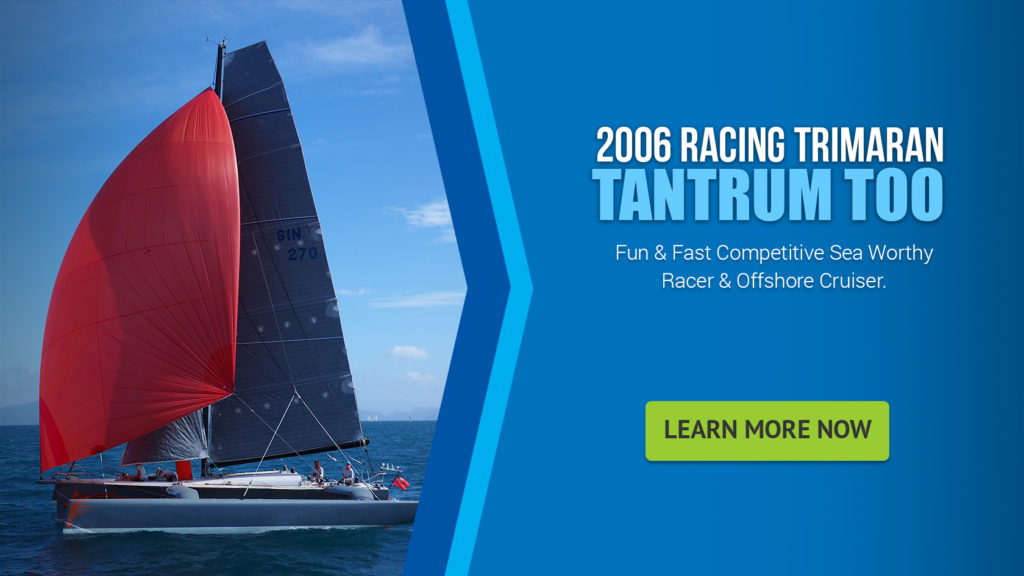
The name trimaran was coined from ‘tri’ and ‘maran’
The ‘trimaran’ name has its origin in two words. It was formed from ‘tri’ and ‘maran’. While ‘tri’ means three, the ‘maran’ part means wood or tree.
Trimarans have a kind of interesting design and architecture that makes them exceptionally fast and powerful. It is thus the preferred vessel for most lovers of speed and water adventure.
Read more: What is the best hull material for a houseboat ?
Trimarans have been around since 2000 BC
Although today’s popular sailing trimarans did not get mainstream acceptance until the 60’s and 70’s, these vessels have been in use and existence long before global acceptance, dating back to about 2000 BC.
In fact, the earliest trimarans are still very much in use today.
The development started with the Austronesia people.
Today, traditional fishermen of the maritime region of Southeast Asia, Micronesia, Madagascar, as well as, the Polynesia regions still use trimaran sailboat similar to the first trimarans.
Trimarans are composed of three main parts
We’ve mentioned this in our description of what a trimaran yacht is.
Every trimaran would have a main or center hull and then two other small outrigger hulls attached to the center hull with lateral beams.
These three components form the basic design for all trimarans and modern trimaran sailboat designs always take this trimaran base.
The center hull is the main hull and is also known as vaka. The two stabilizers on the sides are known as the outrigger hulls, or ama(s).
The main hull offers the most buoyancy
The amas are mainly there to offer more stability to the vessel. Most of a trimaran yacht’s buoyancy is provided by the center or main hull.
This arrangement no doubt offers more flexibility to the design.
Because there is usually a wide separation between the hulls, the trimaran yacht requires only a little buoyancy to keep the yacht stable. This reason is why you’d rarely find trimarans having their outrigger hulls or amas in the water.
Trimarans offer better stability and a super stellar performance
Trimarans, when compared to catamarans which are composed of only two hulls, are more stable.
They offer a better stability and a stellar performance which have even been improved with new technologies infused into the design of these boats.
Trimarans are lightweight and are the preferred choice for boat aficionados and connoisseurs.
The stellar performance advantage which is made possible by the design makes trimarans some of the fastest boats when it comes to yacht racing.
They are perfect for sports sailing and are often winners in water races and competitions.
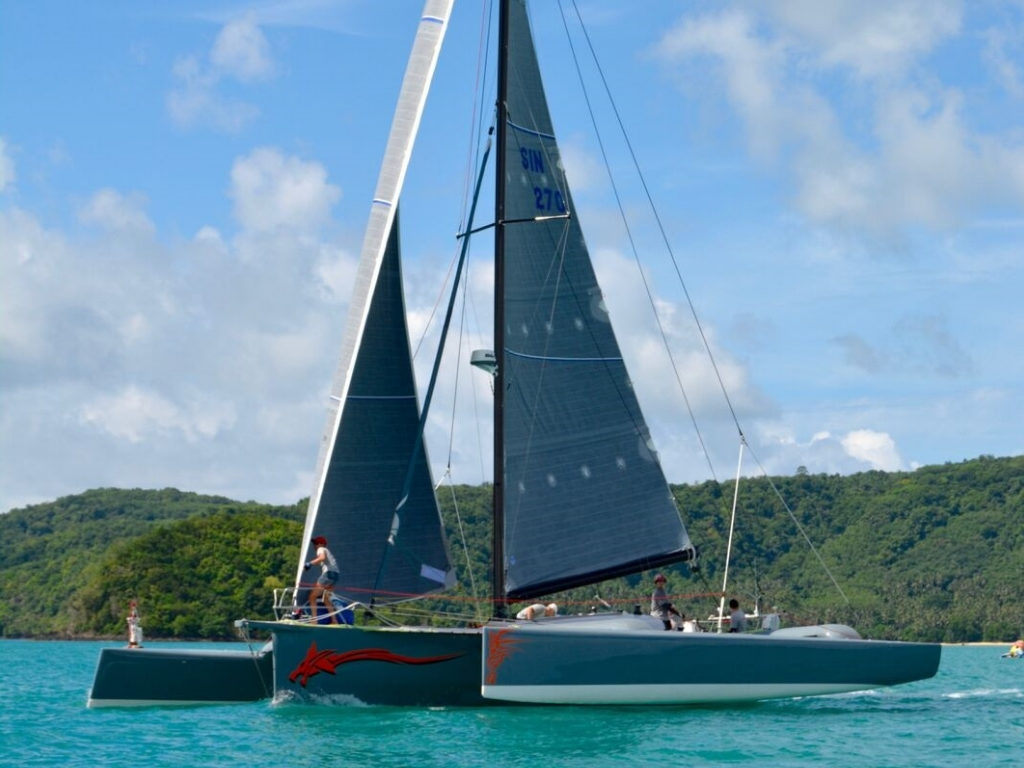
Different types of trimarans
There are basically just two types of trimarans. These are the regular trimaran and the open trimaran.
Instead of plating, the open trimaran rather has a trampoline in between the hulls.
Trimaran yacht advantages over monohull yachts
When compared to single-hulled yachts, trimarans no doubt have some advantages. Some feature differences also exist.
A trimaran, when compared with a monohull of the same length would have a shallower draft. It would also have a wider beam and a less wetted area.
The trimaran though will be able to fly more sail area compared to the single-hulled yacht.
Because of the wider beam, the trimaran has a better straight-line performance when compared with a monohull.
The trimaran can sail in shallower waters and can still perform well while maintaining its stability in the face of stronger winds.
Trimarans are almost unsinkable
Trimarans have a kind of design that is considered almost unsinkable.
This is because even when it is filled with water, the buoyancy of a single outrigger hull or ama can easily keep the entire yacht afloat.
The ama offers greater resistance to the boats and unlike monohulls, trimarans rarely sink.
Because of the high level of safety and stability, sailors with restricted mobility often prefer some special types of trimarans.
Trimarans are like the bridge between catamarans and monohulls
Catamarans, as well as monohulls, have their areas of excellence. Nevertheless, trimaran yachts have certain capabilities which have made them seem like the bridge between monohulls and catamarans at which there is little or no compromise.
Trimaran sailboats are excellent for high speed.
Trimarans generally have moderate weight carrying capability, moderate space below the main deck, and a larger deck area.
The cross deck design between the amas and the main deck is another advantage.
Catamarans usually have large empty gaps in their cross deck bridges.This complexity then necessitates the need for stronger structures, implying more weight, and higher costs. A trimaran yacht would usually have a much smaller cross deck.
There will be a shorter gap between the hulls and the empty space would not extend through the entire yacht’s length.Because of these, less structural weight is required and heavier loads can also be carried on the cross deck.
While catamaran and trimaran yachts are usually built for different purposes, the most obvious difference out of racing is usually the center hull.The center hull of a trimaran yacht will be much larger than the catamaran hulls.
Trimarans are easy to trail, they have a kind of superior handling and are easier to tack, compared to catamarans.
They are easy to manhandle ashore due to their lightweight design.
The lightweight design also makes it easier to use small and inexpensive engines when motoring. With a trimaran yacht, you’d be getting a stellar performance that will get you higher speeds.
If you want more excitement and thrill, perhaps a trimaran yacht such as the racing trimaran Tantrum Too will be very much suitable for you. Tantrum Too is a 12.7m trimaran yacht designed as a concept yacht for a fast ocean cruiser and cruising trimaran.
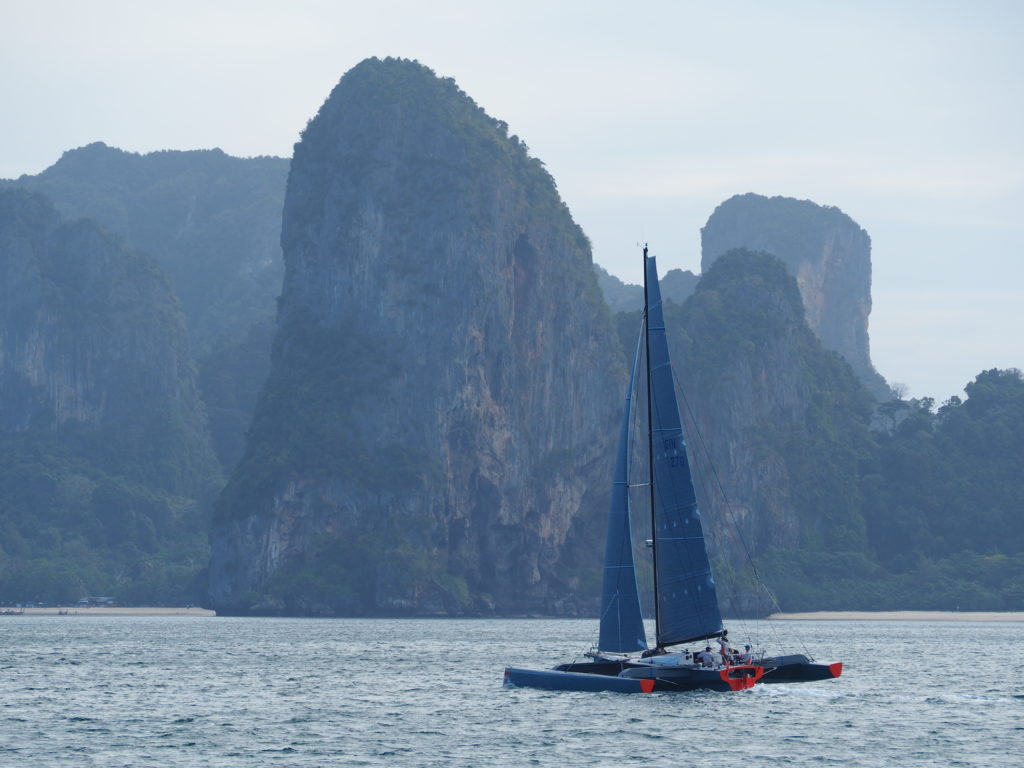
If you’re in the market for a good buy, the trimaran yacht for sale is currently available on auction. You can register here so you can tender your bid for this cruising trimaran.
The purpose of this article is not to pick the better yacht between a trimaran yacht and a catamaran, or a trimaran and a single-hulled boat.
Each of these different watercraft has different areas where they excel. Your choice will most likely have to do with the purpose for which you’re buying.
If you’ve discussed with your sailing crew and have decided to choose a trimaran as your next yacht, all well and good, you’re in for a lot of thrills and fun.
Recent Posts:
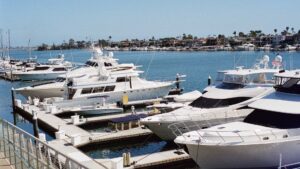
Common Mistakes to Avoid When Buying a Used Boat

Eight Spectacular Boats Awaiting New Owners This Month

Your Ultimate Guide to Yacht Financing in Singapore

Why a Trimaran?
There is a number of reasons why a trimaran makes a great choice of sailboat. As a Trimaran manufacturer we are obviously biased towards three hulls however we will do our best to provide unbiased fact to help you in your decision process.
Lets get started, in no particular order with the features that make a trimaran stand out among a crowd of potential options for you and your family.
Speed On all boats, power-to-weight ratio and wetted surface area are two of the most important factors influencing a boats performance. This equation is most noticeable in multihulls. Every additional kilogram is a potential speed loss. Thus, trimarans are kept at absolutely minimal weight requirements. On a monohull this is less critical as the monohull required a huge amount of lead weight in the keel just to keep it upright! any additional weight is therefore of a lesser % to the total boat weight. Expect to achieve speeds similar or greater to monohulls 30-40% larger than you in your trimaran.
Accessibility Trimarans usually have retractable daggerboards and rudders, All Corsair trimarans combine these features which allows most models to float in as little as 300mm (1′). You now have the ability to explore bays and coves your monohull loving friends have had to avoid. This also gives you the ability to beach your trimaran, no need for a tender, just back up to that sandy beach and step right off. If you’re away from home and bad weather is approaching, this gives you the ability to get the boat safely to shore to avoid damage.
Trailerability (folding trimarans only) All Corsair Trimarans fold on and off the water, a feature which enables them to be picked up on a trailer and stored at home. This ability gives trimaran owners the option to easily explore entire continents. The advantages of trailerability need not be expanded however it is important to consider the ease of trailerability. Some catamarans in the 20-35′ range are trailerable however require a day, sometimes more
Stability A trimaran uses buoyancy in one of it’s two amas to keep the boat sailing level, in contrast to a monohull which uses ballast in its keel. The result of using positive buoyancy and a wide beam is an incredibly level sail. You can comfortably sit around the cockpit, out on the ama or lounge around on the nets, the available deck space is huge. You also see similar stability benefits in cruising catamarans, racing catamarans however tend to be light and flighty, a design intent to reduce wetted surface and increase speed.
Dock Space Not planning on trailering your boat? A trimaran also offers advantages of reduced marina costs when folded. A Corsair trimaran is completely stable when folded and can not only be stored folded but can also be motored out into clear water before unfolding and going out for a sail. The folding is so easy all this can be managed in under 2 minutes.
Space A trimaran when unfolded offers a huge amount of usable space. With wide amas and nets in between the boat offers a nice open and comfortable space for your friends and family to enjoy. No to mention the increased safety for young ones. You also get a similar amount of deck space in a small catamaran however usually on catamarans under 30′ you do not have any accommodation.
Cost This is one area where you can argue a trimaran is outdone by a similar sized monohull. And you would be right, IF you are comparing length for length. But you owe it to yourself to look into this comparison more closely and compare the cost based on the features that matter most to you. EG, if speed is the most important factor for you then you should be comparing the pricing of monohulls approximately 40% larger. Having done this then start to review some of the other features, would this mono hull now be trailerable? Would i have comparable stability and accessibility?
So, should I choose a Trimaran? Unfortunately it’s not a question we can answer for everyone, everybody has different tastes and requirements and needs to make their own assessment of what is important. We will however give you our opinion based on the features and abilities above. We believe that the type of sailboat that will best please an owner differs with the size of boat being offered. Of course there are some exceptions to the rule but for simplicity sake lets brake it down like this:
Sailboats <14′ – Monohulls are a great choice in this size with many cheap training and small single handed dinghies available. Sailboats 14-20′ – Catamarans are the winner in this size range, they are lightweight, easy to trailer, cost effective and great for lakes and protected waters. Sailboats 20′- 32′ – Trimarans are the clear winner here, in this size range a trimaran offers good space in the main hull with berths, storage and protection. It also has a large unfolded platform and power to boot, these are fast boats capable of being easily trailered or cheaply berthed. Sailboats 32′ – 35′ This is a bit of a cross over area, trimarans are starting to get a bit too big to trailer and catamarans too small to best utilize their space, if you are not planning on trailering a trimaran is probably still the standout option here. Sailboats 35′ > Catamarans are the clear cut winner on anything over 35′, they offer a great use of space, good performance and simple sailing systems. There are a number of catamarans on the market which range from floating apartment blocks to outright race boats. Do your research and make sure you are not buying something that fits your requirements, far too many people go and buy one of the first brands they hear and are disappointed by the boats performance, thus giving catamarans an image of slow and heavy. Catamarans actually can perform very well you just need to do your homework. Check out the range of performance cruising catamarans from Seawind Catamarans HERE>>
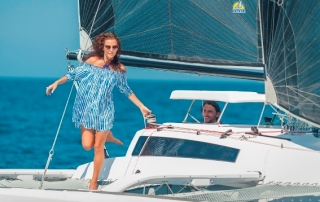
Share This Story, Choose Your Platform!
Related posts.

How To Set Up A Cosair Trimaran

Corsair 880 Trimaran COMPLETE TECHNICAL TOUR
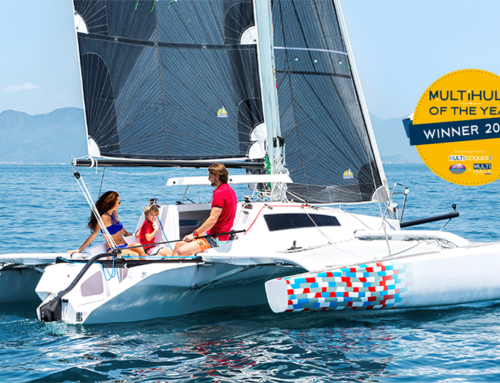
The Corsair 760 offers better performance and versatility
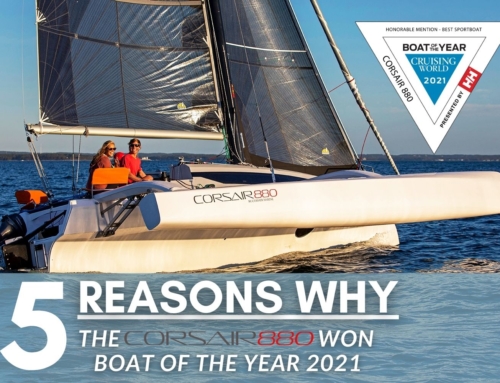
5 Reasons Why the Corsair 880 Won Cruising World’s Boat Of The Year 2021
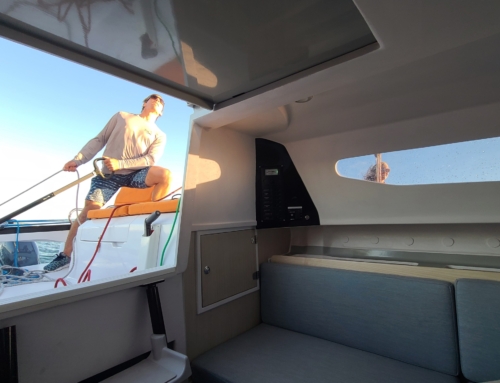
Corsair 880 Interior
Yachting Monthly
- Digital edition

How to sail a trimaran: Expert advice for sailing with three hulls
- Theo Stocker
- February 13, 2024
For their size, trimarans can punch well above their weight in speed, cruising potential and fun. Monohull sailor Theo Stocker gets to grips with how to handle one
Humans tend to gravitate into tribes of like-minded enthusiasts, enjoying the encouragement, support and sense of identity, while often looking askance at others; sailors at motorboaters, cruising sailors at racers, monohull sailors at raft, I mean, multihull sailors, and everyone looks askance at jet-skiers.
Large cruising catamarans (40ft now counts as a small one) are a world apart from monohull sailing, but there’s a sub-tribe of sailors dedicated to life on three hulls and builders such as Dragonfly, Corsair, Farrier, and Astus give them plenty of choice.
I’ve been sailing a 22ft (7m) Astus 22.5 this season, with just enough space for a family of four and a minimum of creature comforts. Thanks to her VPLP-designed hulls and 650kg all-up weight, we can sail upwind at 7-plus knots and downwind at over 10 knots with ease, all on a roughly even keel, while the kids play Duplo down below. It can also be beached and is towable behind a car.
Having, it seems, caught the trimaran bug, I wanted to get better at sailing and handling the boat, but my monohull sailing experience and habits were proving something of a hindrance, so we sought advice from some existing trimaran owners, and well as the UK’s top multihull sailors.
Much of the advice will apply to all multihulls , whether two or three-hulled, while other parts are just for small trimarans. I also found that brushing-up some of my rusty dinghy sailing skills helped get my head around what we were trying to do.
To try out our expert tips we went out sailing to see what difference they made. On the day, we got a solid Force 4-5 southwesterly, averaging 16 knots, but fluctuating between 12 and 20 knots true.
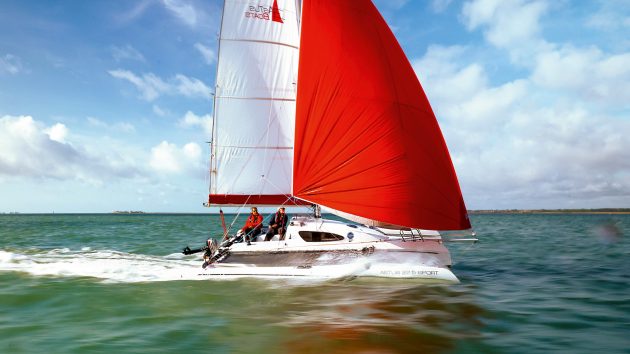
Blasting about on a sporty trimaran is a whole world of fun, but is much calmer than it looks
Trimaran sail trim
One of the biggest differences between a cruising monohull and a multihull is how the mainsail is trimmed. Leech tension on a yacht is often largely controlled by the kicker and the backstay, while the mainsheet sheets the mainsail in and out, predominantly controlling the angle of the boom to the centreline, and there may be a short traveller.
On a mulithull, however, there’s more than enough space for a good, wide traveller. Those who sail on performance monohulls will also be used to this. The sail shape is mainly controlled by the mainsheet, and the traveller then moves the boom towards or away from the centreline.
This is exaggerated on a multihull which has wide shrouds, swept well aft with no backstay, making space for a powerful square-top mainsail with full-length battens. There’s no backstay to bend the mast and flatten what is anyway a pretty rigid mainsail.
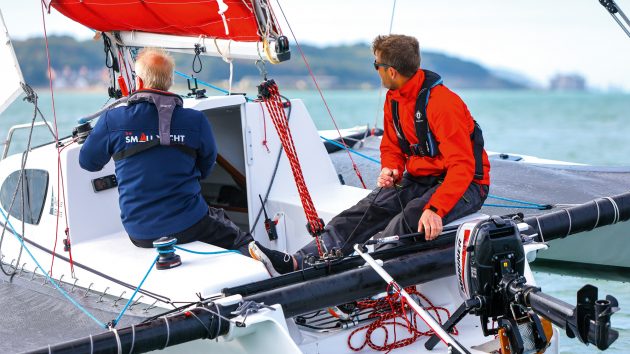
The mainsheet purchase creates enough power to control the leech of the square-top mainsail
Depowering a trimaran
Sailing on a monohull, heel and weatherhelm and eventually a broach give loads of warning that you’re pushing too hard. With straight hulls and little heel, those warning signs don’t really apply to multihulls.
In reality, however, there are a host of warning signals that it’s time to back-off; they’re just a bit different. Even then, there’s still a large safety margin before you get close to danger.
By way of reassurance, with the boat powered up on a beat, Hein, from Boats on Wheels, the boat’s owner, stood on the leeward hull and lent on the shrouds. Even as his feet got wet and the wind gusted at the top of Force 4, the boat didn’t bat an eyelid, thanks to the huge buoyancy of the floats.
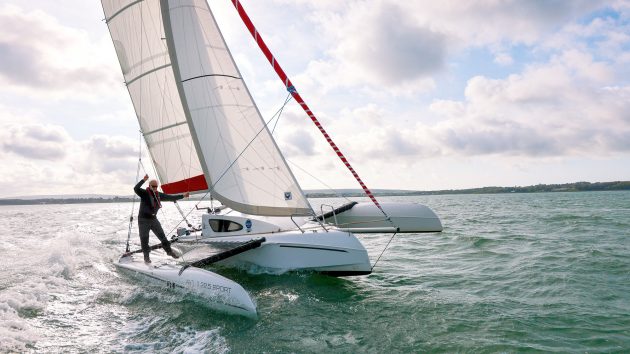
Even with a person on the leeward float the boat was extremely stable
On the water – sail trim
My first inclination was to point the boat as high upwind as possible, pin the sails in and go for height. Doing that resulted in a not-terrible boat speed of 5-6 knots and a good pointing angle.
Free off by a handful of degrees however, and ease the sails just a smidge, and the speed leapt up to 8-9 knots – over 50% more; a huge increase. So, don’t pinch. If you had a decent chartplotter on board, you could find your optimum speed to angle using velocity made good (VMG).
I was also tempted to pinch in the gusts, but it’s better to hold your course and let the speed increase until the main needs easing.
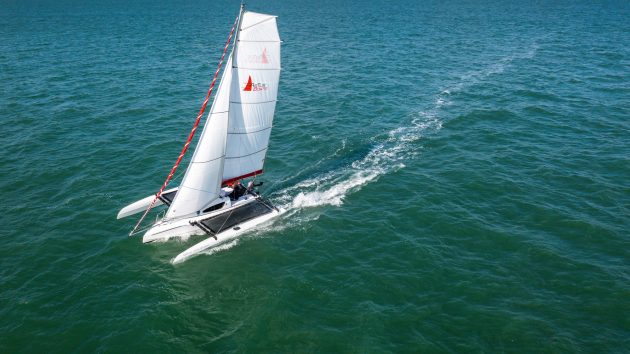
On the wind, it’s time to get the boat fully powered up
If that’s the case, drop the main down the traveller an inch or two or ease some twist into the mainsail and it makes all the difference in the world, but not so far that the top battens fall away and invert – that really isn’t fast. Push too hard and the boat will slow down, largely from the drag of submerging the leeward float and crossbeams. If you’re still overpowered and the main is luffing, it’s time to reef. Downwind is different, but we’ll get onto that later.
After we put a reef in the main, our boat speeds upwind remained largely the same, and the boat was much happier. I came away feeling reassured that even a little trimaran like this would be pretty difficult to capsize, and there were always plenty of warning signs telling me to take my foot off the pedal a little.
Article continues below…

Catamaran sailing skills: Mooring and anchoring a multihull
How do you make an average passage speed of 7 knots, fit in three double cabins and a huge saloon…

Monohull or multihull: which is best for blue water?
As former editor of Yachting World, David Glenn has plenty of experience of both monohull and multihull cruising. Here he…
Tacking and gybing a trimaran
Everyone knows that multihulls don’t tack as well as monohulls. Straight hulls and wide beam don’t lend themselves to turning, especially when coupled with the displacement and fixed keels of big cats. Trimarans are a little easier, with a single central daggerboard to act as a pivot, and one or other of the floats will generally be clear of the water. On the downside, light displacement means that there isn’t much momentum to keep you going through the turn and plenty of windage to stop you.
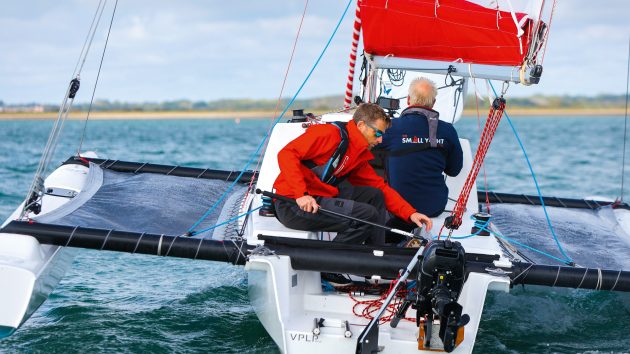
On a trimaran the central daggerboard helps the boat to turn by providing a central pivot point that catamarans lack
Speed is your friend. Build speed up before the tack to give you as much momentum as possible. The helm needs to steer positively into and through the turn, and if necessary, keep the jib backed on the new windward side to help the bow through the wind. Don’t worry about scrubbing speed off, but you don’t want to get stuck in irons.
When it comes to gybing, speed is again key. The turning bit isn’t going to be an issue as you’ll be scooting along, but the faster you’re going, the less load there will be on the sails. The more you slow down, the more the true wind will pile up.
Trimaran sailing skills
Tacks took a bit of practice. It felt plain wrong to jab the tiller across the boat, slamming a big break on in the water but I ended up putting us through the tacks far too slowly, losing a lot of speed. A more aggressive approach worked better. On the Astus, the traveller was between me and the tiller, so the tiller extension needed to be swung around the stern behind the mainsheet onto the new side.
Similarly, old habits of controlling a gybe needed to be modified. With the asymmetric set, we were planing at well over 10 knots, and the ideal is to stay on the plane. Heading dead downwind and centring the main lead to a more violent manoeuvre than flying into the gybe as fast as possible and, as the boom was never that far out thanks to the apparent wind angle, it didn’t need much extra controlling.
Coming up onto the wind after the gybe helped the asymmetric around the front of the jib and to fill on the new side. Stay too deep and it’ll get blanketed by the main. Once we had built up some apparent wind, we could bear away again.
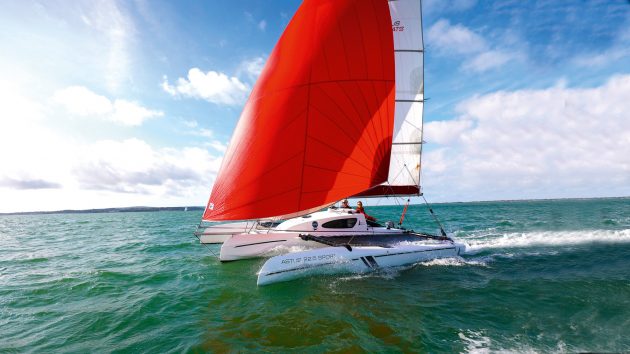
You’ll be on a course deep downwind before you know it, hitting speeds in the double digits
Downwind in a trimaran
Upwind cruising may be fun in a multihull, but bearing away and going with the wind is what it’s all about. Easily-driven hulls, a generous sailplan and light weight mean you can be up and planing, leaving displacement boats wallowing in your wake.
The big difference comes from apparent wind. If you’re in a boat that can do 15 knots downwind in 20 knots of true wind, the resulting wind angles can really mess with your head.
To get going then, says Brian Thompson, ‘Use those leech tell-tales again when sailing downwind and reaching to set the correct twist through the mainsheet, and use the traveller to set the correct angle of the whole sail to the wind.’
As the wind and your speed builds, bear away and trim the main accordingly.
In theory, you shouldn’t need to ease the traveller at all, but you may need to if you want to sail deep downwind. As the gust fades, you’ll find the boat slows down, so you can come back up towards the wind a little to pick up some more breeze, and then bear away as you accelerate again.

Bear away as the boat accelerates. Your course will be something of a slalom as you look to keep a consistent wind angle
This results in something of a ‘slalom’ course, and will also be accentuated if you’re sailing down waves, but that’s all quite normal for apparent wind sailing. Ultimately, you’re looking for a consistent apparent wind angle, even if the resulting wake isn’t straight.
It’s worth remembering that apparent wind reduces the felt effect of the wind, so you need a sailplan to suit the true, not apparent wind speed.
I found that the boat was more sensitive to having a balanced sailplan and trim downwind than upwind, largely because you’ve got almost double the canvas up, with the bowsprit as an extra lever. When weather helm built, I needed to ease the mainsheet to increase twist to depower so that I could bear away. I must admit, getting the boat balanced, sailing fast and light on the helm at 15 knots was something I came away feeling I needed more practice at.
Reviewing the images, I suspect the asymmetric was sheeted in too hard, with too much twist in the main.
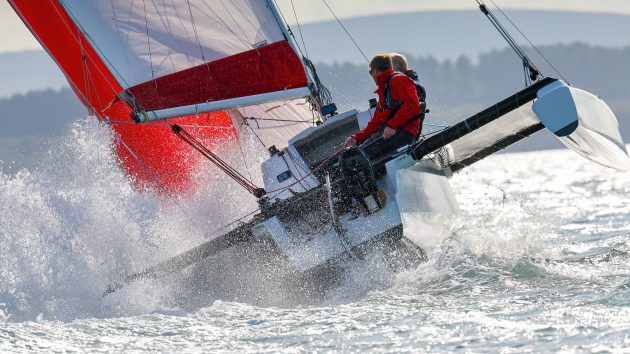
Getting a float fully submerged is when it’s time to back off
On the water
Unfurling the gennaker worked best on a beam reach, giving plenty of airflow over the sail to help it fully unfurl. This was also roughly the fastest point of sail, ideal for getting up some speed for apparent wind sailing. We mostly had the sails set for a close reach, even when we were beyond 120º off the true wind on a broad reach.
It was possible to soak deeper downwind, but lose the apparent wind benefit downwind and our speed dropped off dramatically, prompting us to point a bit higher to find some more speed.
As the boat powered up, it paid to hold a slightly higher angle than I would have done in a monohull for the boat to properly take off and get up into double digit speeds – topping out at 15 knots. Lymington to Cowes would have taken us just half an hour at that speed. It’s easy to give yourself a heck of a beat back!
We were sailing on a pretty flat day, so didn’t have to contend with any waves to speak of. On the recent RTI this is what caused the capsizes of at least two multis, a sobering reminder that you need to sail much more conservatively in lumpier conditions.
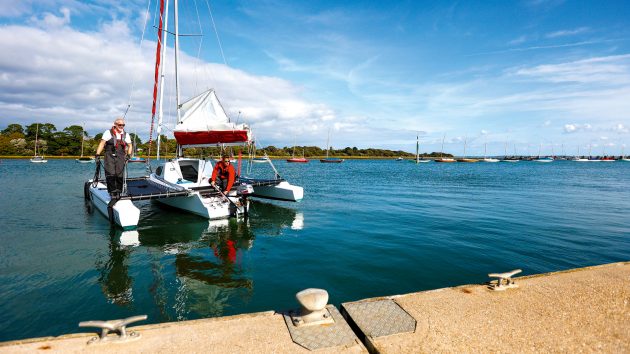
The bows want to point downwind, so a stern-first approach works with rather than against the boat
Coming alongside
A 650kg boat with no draught and plenty of windage feels dreadfully skittish when manoeuvring in confined spaces. Straight hulls with no forgiving curves and fragile-looking sharp bows make berthing tricky. You’ve got a couple of advantages on your side, however. In the Astus, the floats are at pontoon height making stepping off easy.
Whether you have an engine in each hull of a cat, or one in the central hull of a tri, there’s also a lot more leverage to play with to turn the boat and drive her on or off the pontoon. A steerable outboard gives you even more options.
If the boat has a lifting keel or daggerboards, put them down if there’s enough depth to give you a pivot and to resist drifting. Think about getting corners onto the pontoon, rather than putting the boat alongside. On tris, you won’t be able to get to the bow to fend off as it’s too narrow. You can rig a fender up forwards on a line, and two fenders are enough on the flat sides.
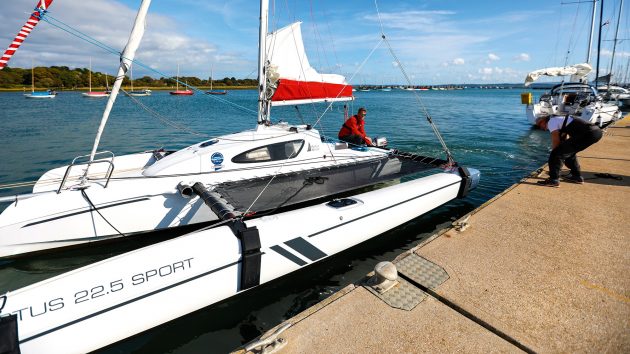
Steering with the outboard towards the pontoon will drive the stern in more; steer away to drive the bow in more
Offshore wind
Coming onto the pontoon with wind blowing off, it worked well coming in stern first. If there’s a tide running, you’ll want to be heading into the tide, so find a spot down wind and down tide to start your approach so you come in at an angle.
On our first attempt we had a bit of tide under us to start with so we came in at a much steeper angle, almost 90º, although this worked out OK in the end.
The crew could then step ashore, taking a line from the stern quarter round a cleat.
Drive forwards against the line and the bow will obediently drive up towards the pontoon, bringing you flat alongside. Getting off was simple, releasing the bowline, and allowing the bow to swing out the before slipping the stern line.
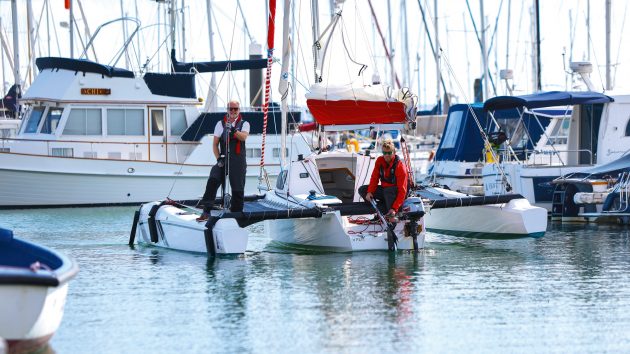
Coming in astern and stopping upwind of the berth meant the bows blew towards the pontoon far to quickly
Onshore wind
Getting onto and off a pontoon with onshore wind proved rather trickier. On our first attempt we came in stern first. The issue was that once we were just upwind of our desired berth and stopped, we lost steerage and the bow immediately blew off with alarming speed towards the pontoon.
Going ahead would only increase the force of the impact, while going astern only increased the bow’s sideways drift. I managed to back out without smashing the bow, but only just, and ended up awkwardly stern to the wind with the bows pointing at the pontoon.
On our second attempt we came in bows first but having aimed at the berth, I had to motor the stern to leeward to stop the bow hitting, making for a rather forceful coming alongside.
On take three, I came in forwards and began ferry gliding towards the berth early, keeping the bows to windward of the stern. Being able to steer with the outboard meant I could go ahead to keep the bow up, and go astern with the engine pulling the stern down toward the pontoon. In this way, it was possible to come in pretty well controlled and parallel to the berth.
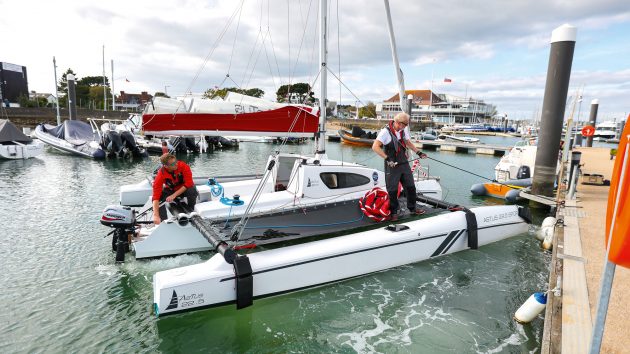
To get out, motoring astern against a bow line pulled the entire boat clear before slipping the line
Leaving was a different proposition all together, as I didn’t want to drag the bow along the pontoon, or to drive hard onto it to spring off. Instead, we rigged a slip-line from the forward cross beam. Going astern against this, and then turning the engine towards the wind, I could pull the stern, and the rest of the boat, out and away from the pontoon.
Keeping power on astern, once we’d reached a decent angle, we slipped the line and went astern, finding steerage way almost at once, with the bow following obediently in our wake with more control than I had anticipated.
Whether the wind is blowing onto, or off the pontoon, you want the engine to be driving or pulling the boat off the pontoon with a line on the corner you are going away from. That way you avoid point-loading fine ends where it’s hard to fender.
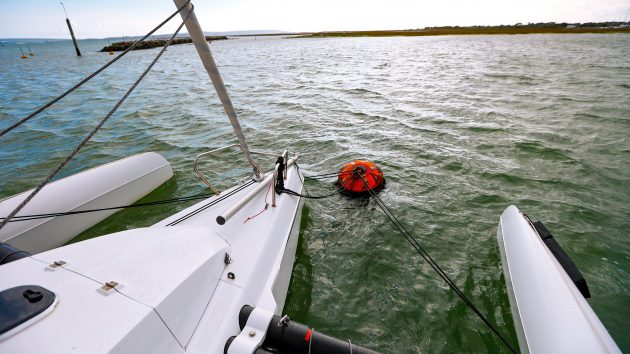
You’ll want a bridle to reduce swinging, but keep the pick up lines on the bow as backup
Anchoring and mooring a trimaran
While mooring a catamaran is complicated by the lack of a central bow, things should be simpler on a trimaran, and they are, mostly. Picking up a mooring buoy from the main hull bow with a low freeboard and dropping the pick-up line onto a cleat is easier even than a monohull.
The bow may be narrow, but for any lines that pass through a ring on the buoy, you still need to take it back to the same cleat to avoid chafe. That should be it, but windage from the two extra bows and the lack of keel mean the boat can dance merrily around the mooring buoy in a breeze.
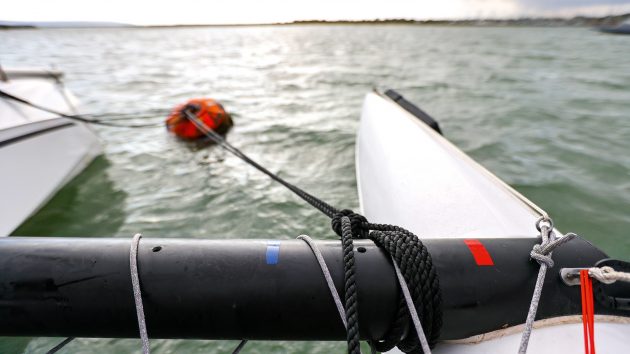
Rig the bridle so the buoy sits to one side to stabilise the boat
In practice, we found that a trimaran benefits from a mooring bridle in the same way that a catamaran does. It can’t be rigged from the floats’ bows, as there are no mooring cleats, so a line passed around the outboard ends of the forward beams gave a pretty good angle, again with long lines passed through the mooring and back to the same side. The main pick-up lines stay as a safety backup.
The other trick is to rig the bridle asymmetrically so that the buoy sits to one side or the other, just enough to not be dead head to wind, making it much more stable in the wind.
On the plus side, the lack of draught or keel means that you’ll nearly always be lying head to wind, so the cockpit remains nice and sheltered whatever the tide’s doing.
We ran out of time on the day to try anchoring, but rigging a bridle, effectively a long snubber to a point on the anchor chain in a similar way wouldn’t be tricky.
If you needed not to swing, or to behave more like deeper boats nearby, hanging a bucket over the stern can help, or there’s always anchoring with a kedge, either out ahead in a V, or in line astern.
Enjoyed reading this?
A subscription to Yachting Monthly magazine costs around 40% less than the cover price .
Print and digital editions are available through Magazines Direct – where you can also find the latest deals .
YM is packed with information to help you get the most from your time on the water.
- Take your seamanship to the next level with tips, advice and skills from our experts
- Impartial in-depth reviews of the latest yachts and equipment
- Cruising guides to help you reach those dream destinations
Follow us on Facebook , Twitter and Instagram.

TRIMARAN VS CATAMARAN
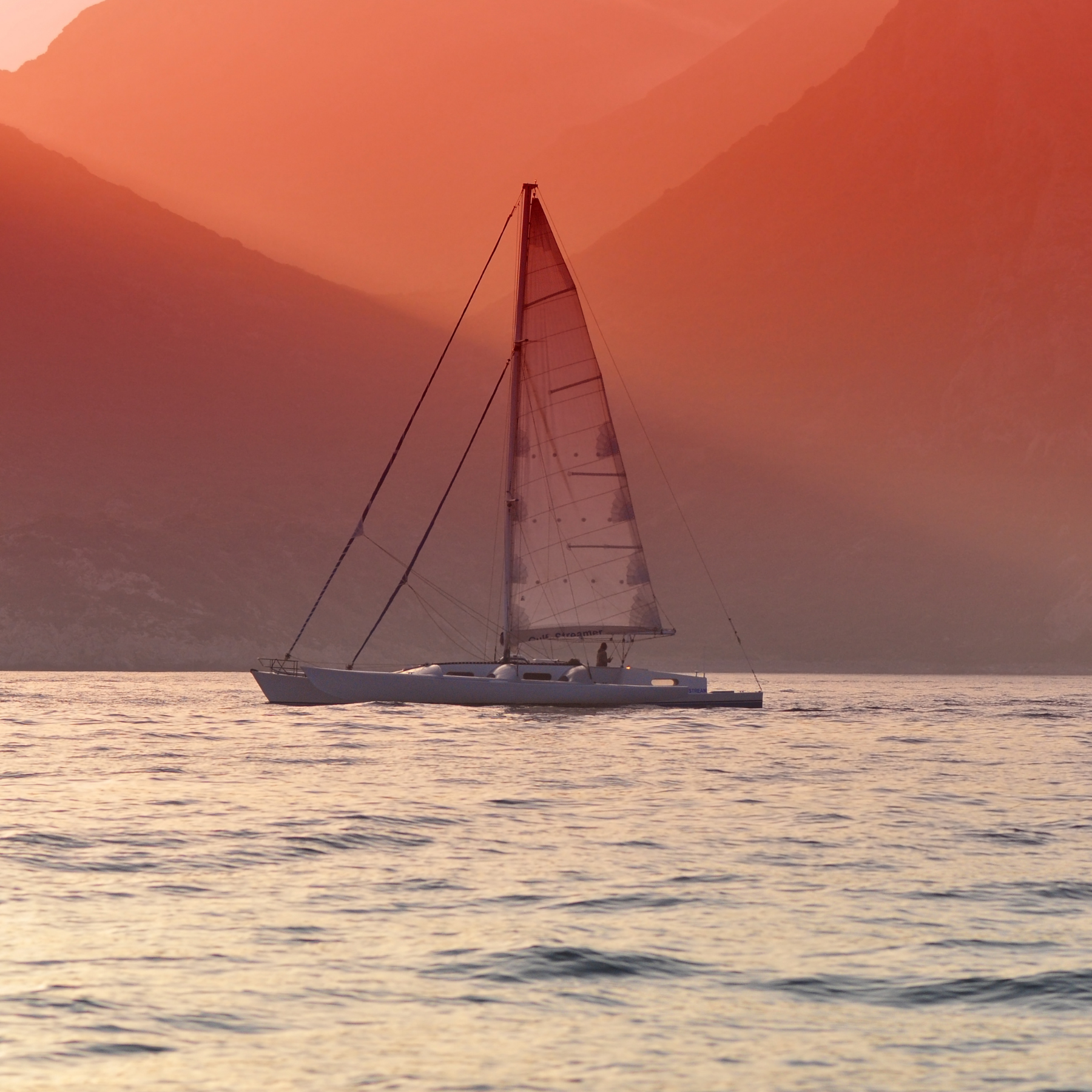
Trimarans and catamarans have a unique appeal. They are stable, fast, and comfortable. Yet, it can be hard to choose between these kinds of vessels, if you have the budget to charter or buy either.
In this article, we delve into the trimaran vs catamaran debate to establish the pros and cons of both. But first, let’s look at the key differences between them.
What are the differences between trimarans and catamarans?
A trimaran has one main, larger hull flanked by two smaller “floats”, connected by lateral beams. It’s rigged similarly to a monohull and heels. The extra hull offers less hydrodynamic resistance, which makes a trimaran faster.
Catamarans have two equal-sized parallel hulls; their wide beams offer stability. That’s why cats don’t heel.
Catamarans have become extremely popular over the past decades, especially once bigger, more comfortable models have been produced since the 90s. So much so, that there’s a rather long waiting list to get a new one built. Charter companies are purchasing more and more cruising cats to add to their fleets and many cruisers choose a cat over a monohull when they set sail on a long voyage.
Trimarans have been associated with racing only, until recently. However, new and rather spacious recreational models are slowly emerging. Finding a cruising trimaran to charter is still hard, though.
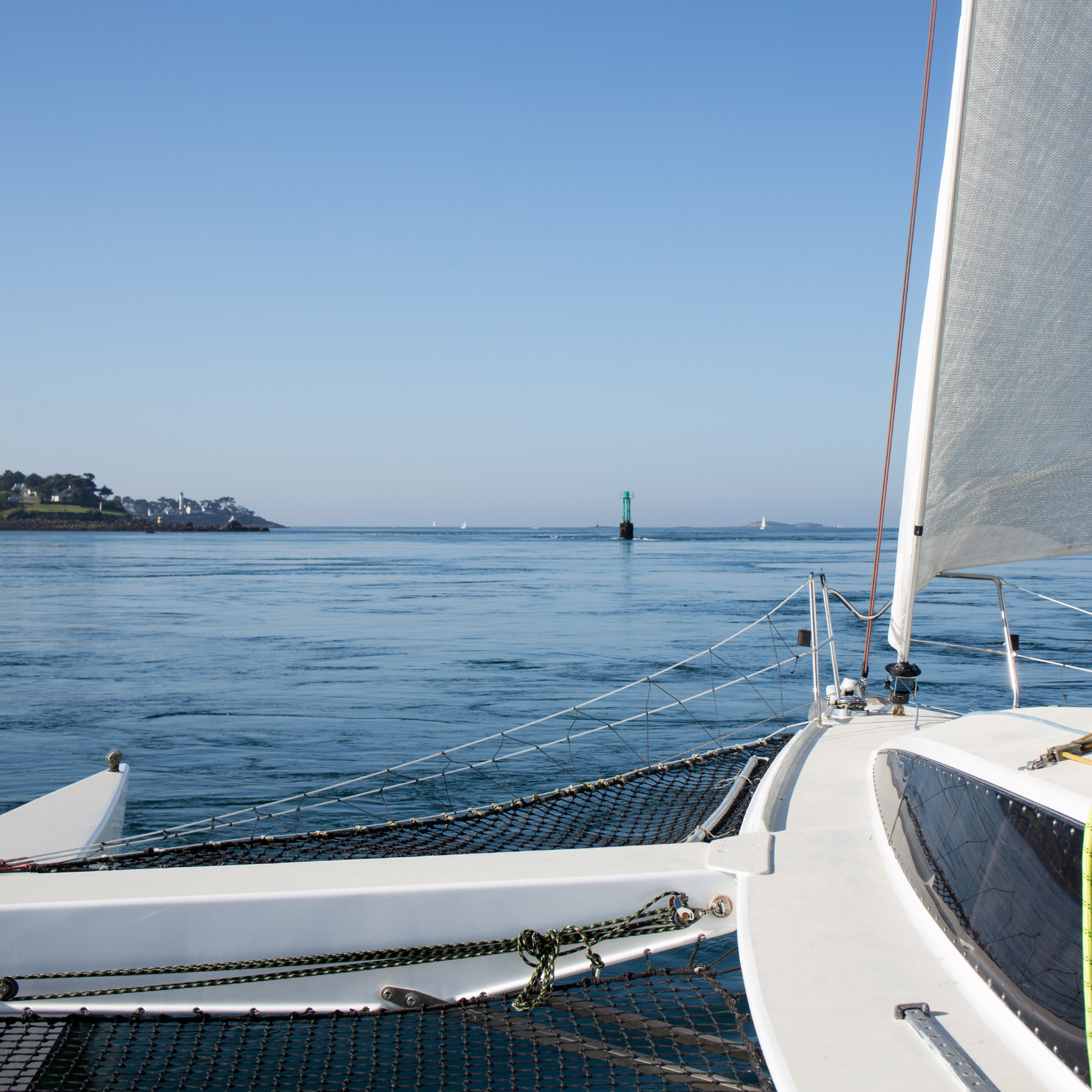
Can a trimaran capsize?
In theory, in extreme conditions, if a wave is higher than half the beam size of the boat, a trimaran can capsize. However, trimarans are rather wide vessels and their three-hull configuration makes them very stable.
A trimaran has a maximum righting moment of 27 degrees of heel, while a catamaran has a 12 degree one. Such a shorter angle can be reached in short seas, if the wind gusts are powerful enough and you haven’t reefed.
So capsizing a trimaran is extremely hard. Plus, if a trimaran flips over, it is virtually unsinkable, thanks to the three hulls. This extra safety element has led to trimarans becoming more popular than catamarans in the racing world.
Is a trimaran safer than a catamaran?
To a small extent. As we have seen above, it’s very difficult to sink a trimaran. The same goes for cats. However, trimarans have the added bonus of being harder to flip over, too.
Get the free DECKEE boating app
DECKEE helps you plan, prepare and explore the waterways with confidence.
Download app
Pros and cons of Trimarans
Let’s look at the advantages and disadvantages of trimaran sailboats.
Trimarans are very fast, typically faster than both cruising and racing catamarans
They can sail in nearly any wind conditions
Trimarans are extra stable and hard to flip over
The heeling allows you to understand when it’s time to reef
Trimarans perform better upwind than cats
The helm offers great feedback, just like on a monohull
The anchoring gear is easier to deploy, as it’s installed on the main hull.
Sailing a trimaran takes quite a bit of work on deck
They heel, making it harder to cook underway
Trimarans can be harder to maneuvre inside a marina
The space on board is typically less than on most cats
Trimarans are very weight sensitive.
Pros and cons of catamarans
Catamarans, on the other hand, have their own pros and cons.
Cats offer a stable platform underway and at anchor
Maneuvering a catamaran is very easy
Modern, cruising cats, feature lots of room above and below deck
Catamarans don’t heel
Cruising catamarans can bear a decent amount of load.
Racing cats aren’t very spacious
Catamarans can be capsize more easily than trimarans
You need to reef more often on a cat
Any catamaran is slower than a trimaran
The helm isn’t very responsive - you need to pay close attention to the instruments.

The verdict: Trimaran or catamaran?
As always, when it comes to boats, there isn’t a “better option”. A vessel needs to be tailored to the needs and preferences of her owner.
If you prefer sailing a beautiful, spacious platform, on which to cruise leisurely and entertain many guests, a cruising catamaran may be the choice for you. You won’t need to handle the lines and halyards quite as often, you won’t heel, but you will travel slower.
If, on the other hand, you enjoy the thrill of high speeds, but you’re worried about safety, a trimaran may be right for you. A recreational trimaran fitted with daggerboards or centreboards can typically sail faster than a catamaran and perform better upwind.
A performance cat may be a great option for those who need to get in and out of marinas often but want to sail fast. And if you want the fastest, most fun boat to sail, opt for a racing trimaran.
Whatever your priorities, a boat that’s the perfect balance between them all exists. Although, of course, you will need to take budget into consideration.
HOW TO GET SAILING EXPERIENCE
How to prepare for a boating trip.
- New Sailboats
- Sailboats 21-30ft
- Sailboats 31-35ft
- Sailboats 36-40ft
- Sailboats Over 40ft
- Sailboats Under 21feet
- used_sailboats
- Apps and Computer Programs
- Communications
- Fishfinders
- Handheld Electronics
- Plotters MFDS Rradar
- Wind, Speed & Depth Instruments
- Anchoring Mooring
- Running Rigging
- Sails Canvas
- Standing Rigging
- Diesel Engines
- Off Grid Energy
- Cleaning Waxing
- DIY Projects
- Repair, Tools & Materials
- Spare Parts
- Tools & Gadgets
- Cabin Comfort
- Ventilation
- Footwear Apparel
- Foul Weather Gear
- Mailport & PS Advisor
- Inside Practical Sailor Blog
- Activate My Web Access
- Reset Password
- Pay My Bill
- Customer Service

- Free Newsletter
- Give a Gift

How to Sell Your Boat

Cal 2-46: A Venerable Lapworth Design Brought Up to Date

Rhumb Lines: Show Highlights from Annapolis

Open Transom Pros and Cons

Leaping Into Lithium

The Importance of Sea State in Weather Planning

Do-it-yourself Electrical System Survey and Inspection

Install a Standalone Sounder Without Drilling

When Should We Retire Dyneema Stays and Running Rigging?

Rethinking MOB Prevention

Top-notch Wind Indicators

The Everlasting Multihull Trampoline

How Dangerous is Your Shore Power?

DIY survey of boat solar and wind turbine systems

What’s Involved in Setting Up a Lithium Battery System?

The Scraper-only Approach to Bottom Paint Removal

Can You Recoat Dyneema?

Gonytia Hot Knife Proves its Mettle

Where Winches Dare to Go

The Day Sailor’s First-Aid Kit

Choosing and Securing Seat Cushions

Cockpit Drains on Race Boats

Rhumb Lines: Livin’ the Wharf Rat Life

Re-sealing the Seams on Waterproof Fabrics

Safer Sailing: Add Leg Loops to Your Harness

Waxing and Polishing Your Boat

Reducing Engine Room Noise

Tricks and Tips to Forming Do-it-yourself Rigging Terminals

Marine Toilet Maintenance Tips

Learning to Live with Plastic Boat Bits
Comparing trimarans & catamarans.
Trimarans tend to be more performance oriented than catamarans. In part, this is because it’s easier to design a folding trimaran, and as a result Farrier, Corsair, and Dragonfly trimarans had a disproportionate share of the market.
In spite of this and in spite of the fact that many are raced aggressively in windy conditions, capsizes are few, certainly fewer than in equivalent performance catamaran classes. But when they do go over, they do so in different ways.
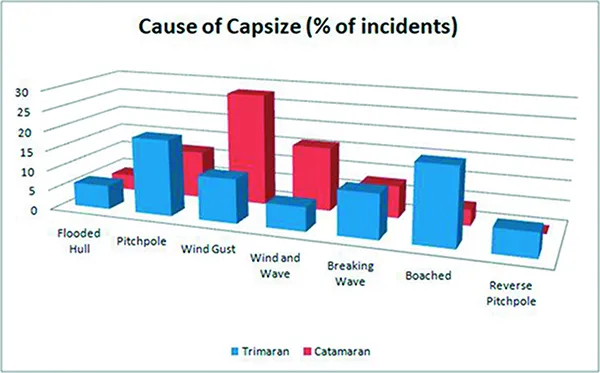
Trimarans have greater beam than catamarans, making them considerably more resistant to capsize by wind alone, whether gusts or sustained wind. They heel sooner and more than catamaran, giving more warning that they are over powered.
Waves are a different matter. The amas are generally much finer, designed for low resistance when sailing deeply immersed to windward. As a result, trimarans are more susceptible to broach and capsize when broad reaching at high speed or when caught on the beam by a large breaking wave.
In the first case, the boat is sailing fast and overtaking waves. You surf down a nice steep one, into the backside of the next one, the ama buries up to the beam and the boat slows down. The apparent wind increases, the following wave lifts the transom, and the boat slews into a broach. If all sail is instantly eased, the boat will generally come back down, even from scary levels of heel, but not always.
In the second case a large wave breaks under the boat, pulling the leeward ama down and rolling the boat. Catamarans, on the other hand, are more likely to slide sideways when hit by a breaking wave, particularly if the keels are shallow (or raised in the case of daggerboards), because the hulls are too big to be forced under. They simply get dragged to leeward, alerting the crew that it is time to start bearing off the wind.
Another place the numbers leave us short is ama design. In the 70s and 80s, most catamarans were designed with considerable flare in the bow, like other boats of the period. This will keep the bow from burying, right? Nope. When a hull is skinny it can always be driven through a wave, and wide flare causes a rapid increase in drag once submerged, causing the boat to slow and possibly pitchpole.
Hobie Cat sailors know this well. More modern designs either eliminate or minimize this flare, making for more predictable behavior in rough conditions. A classic case is the evolution of Ian Farrier’s designs from bows that flare above the waterline to a wave-piercing shape with little flare, no deck flange, increased forward volume, and reduced rocker (see photos page 18). After more than two decades of designing multihulls, Farrier saw clear advantages of the new bow form. The F-22 is a little faster, but more importantly, it is less prone to broach or pitchpole, allowing it to be driven harder.
Beam and Stability
The stability index goes up with beam. Why isn’t more beam always better? Because as beam increases, a pitchpole off the wind becomes more likely, both under sail and under bare poles. (The optimum length-to-beam ratios is 1.7:1 – 2.2:1 for cats and 1.2:1-1.8:1 for trimarans.) Again, hull shape and buoyancy also play critical roles in averting a pitchpole, so beam alone shouldn’t be regarded as a determining factor.
Drogues and Chutes
While monohull sailors circle the globe without ever needing their drogues and sea anchors, multihulls are more likely to use them. In part, this is because strategies such as heaving to and lying a hull don’t work for multihulls. Moderate beam seas cause an uncomfortable snap-roll, and sailing or laying ahull in a multihull is poor seamanship in beam seas.
Fortunately, drogues work better with multihulls. The boats are lighter, reducing loads. They rise over the waves, like a raft. Dangerous surfing, and the risk of pitchpole and broach that comes with it, is eliminated. There’s no deep keel to trip over to the side and the broad beam increases the lever arm, reducing yawing to a bare minimum.
Speed-limiting drogues are often used by delivery skippers simply to ease the motion and take some work off the autopilot. By keeping her head down, a wind-only capsize becomes extremely unlikely, and rolling stops, making for an easy ride. A properly sized drogue will keep her moving at 4-6 knots, but will not allow surfing, and by extension, pitch poling.
For more information on speed limiting drogues, see “ How Much Drag is a Drogue? ” PS , September 2016.
- Privacy Policy
- Do Not Sell My Personal Information
- Online Account Activation
- Privacy Manager
Call Us (561) 445-5664
Trimaran vs. Catamaran: Which is Better?
Most Popular , Yachting
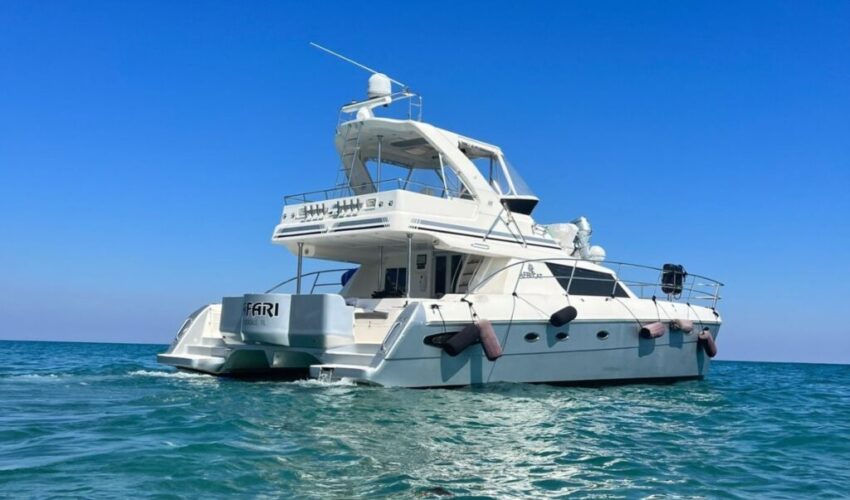
Published September 26, 2023
The majority of boat enthusiasts have experimented with various types of boats. There are so many options that it’s nearly hard to determine which is the “greatest” or “ultimate” boat. It’s entirely up to personal preference, weather conditions, and your objective. Now let’s find out which is better, trimaran vs. catamaran.
Monohulls Are Out of Trend
If you want to improve your sailing skills fast, there is nothing better than sticking to a small monohull and learning everything it offers. Monohulls are conventional boats, the type we are accustomed to in the Western world — a single long hull with a sail protruding from the center. While most boats in Europe are monohulls, the popularity of multihulls has recently increased.
There are various reasons, but the primary one is that modern people do not want to spend their time on the boat doing too much work. Why bother when you can simply lay back, relax, and allow the wind to care for itself?
Regular monohull sailing yachts are notoriously difficult to steer, and if something goes wrong, they fall to the bottom of the water, becoming nothing more than a fish apartment. Multihulls — trimarans and catamarans – are non-sinkable, making them highly safe and easy to operate.
Trimarans, like catamarans, are multi-hulled watercraft. As the name implies, they have a second hull compared to catamarans. The trimaran’s three hulls make it entirely unsinkable.
Thus, even in the worst inclement weather, the risk of capsizing is minimal. And even if the trimaran turns over, it will remain afloat, transforming it into an ideal life raft. This is helpful information while out sailing, and it should be reassuring. And if the worst-case scenario occurs, i.e., capsizes , the trimaran will be easily visible, particularly from a helicopter.
Trimarans are also more enjoyable to sail since they have a large hull in the center and two small hulls on either side. Thus, they combine the advantages of a monohull with the stability of a catamaran, effectively combining the best of both worlds.
You’ve almost certainly seen a catamaran or two in your life. They are uncomplicated vessels, yet they look great. Catamarans have two hulls rather than one, so they are called multihulls.
Numerous advantages accrue as a result of the more excellent stability indicated previously.
The smaller vessels are enjoyable to sail and may hold between 2 and 10, 15, or even 20 people. Then there are the larger catamarans, which can carry up to thirty people. These may be seen across the Mediterranean and a few other locations, where they are used as tiny ferries. (Related: Catamaran vs. Monohulls: Pros and Cons )
Trimaran vs Catamaran: The Differences
When comparing trimarans and catamarans, there are several key differences to consider:
Trimarans tend to offer greater stability compared to catamarans. Trimarans have three hulls, with outriggers acting as stabilizers, providing a stable platform even in rough seas.
Maneuverability
Catamarans are easier to maneuver due to their twin hull design. They can make tight turns and navigate shallow waters with relative ease.
Trimarans are generally faster than catamarans. They have a streamlined design. Their lighter weight allows them to meet higher speeds, especially when sailing upwind.
Interior Space
Catamarans generally offer more interior space and living quarters compared to trimarans. The wider beam of a catamaran allows for larger cabins, saloons, and deck areas.
Sailing Performance
Trimarans are known for their excellent upwind performance. Their narrower hulls and center hull configuration make them more efficient when sailing against the wind.
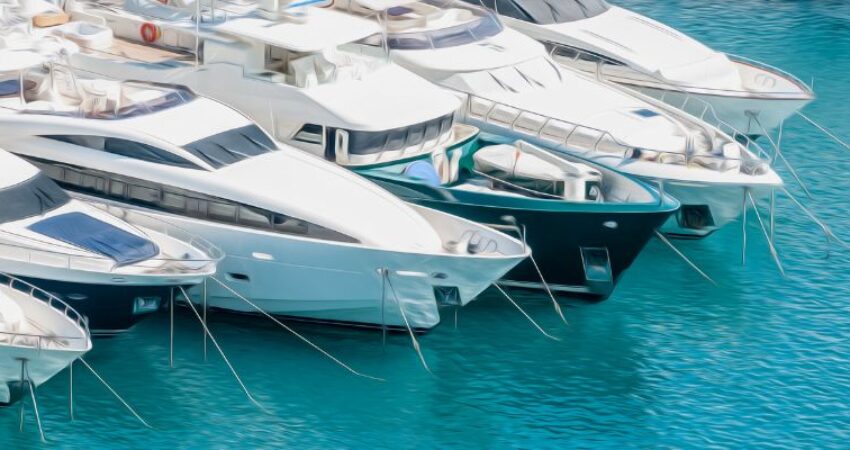
Which is better: Trimaran or Catamaran?
Catamarans are often considered better for sailing than trimarans for several reasons. They offer unparalleled stability with their twin-hull design. This makes them less prone to capsizing than trimarans.
Its stability provides a safe and comfortable sailing experience, particularly in rough seas. Additionally, catamarans excel in maneuverability. Their separate hulls allow them to make tight turns and navigate through shallow waters effortlessly.
Furthermore, catamarans tend to provide more interior space and living quarters. They offer ample room for relaxation and entertaining guests. Their wider beam also performs better in light winds, ensuring smooth sailing even when the wind weakens.
Lastly, catamarans typically have a shallower draft. This grants access to shallow anchorages and marinas, expanding their range of exploration.
The Seafari Catamaran
The Seafari catamaran is a 42′ power catamaran yacht that offers a unique and unforgettable experience on the water. It has an ultra-wide design. And it provides a spacious and comfortable environment that rivals much larger yachts.
It has essential fishing gear, coolers, grills, and supplies. So guests can enjoy a day of fishing and grilling their catch onboard. Snorkeling equipment is also available for those who want to explore the underwater world.
The yacht features below-deck bedrooms and a functioning bathroom. This ensures that guests have all the necessary amenities for a comfortable stay. Safety is a top priority, as the yacht has a liferaft and vests. The experienced and licensed Seafari captains ensure guests have a great and safe time on the water.
Whether cruising the intercoastal, hosting parties or enjoying romantic dinner cruises, the Seafari catamaran offers endless possibilities for fun and adventure.
Trimaran Vs Catamaran: Conclusion
- If you want stability and minimal work, choose a catamaran.
- If you want to improve your sailing skills while remaining safe at all times, opt for the trimaran.
- Opt for the trimaran if you want to be the fastest sailor on the water.
- If you want to host incredible events on board, opt for the catamaran.
Experience Yacht Charters With Seafari In Boca Raton Florida
Looking for a great time on the water in Boca Raton Florida? Seafari Yacht Charters is number choice for yacht rentals in Boca Raton . Book our yachts for parties , exciting day trips to the Bahamas, romantic yacht dinner cruises , and much more. Come experience all South Florida has to offer with us.
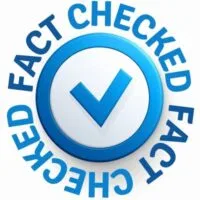
Fact Checked By Experts
Our team of internal experts has conducted rigorous fact-checking on this content. Explore the editorial standard for our website to dive deeper into our commitment to excellence.

About The Author
With expertise in multiple fields, Rei Bayucca offers readers captivating and insightful articles. Through her writing, she aims to engage and enlighten readers with thought-provoking content. Experience and dedication ensure that her work is well-crafted and impactful.
Related Posts
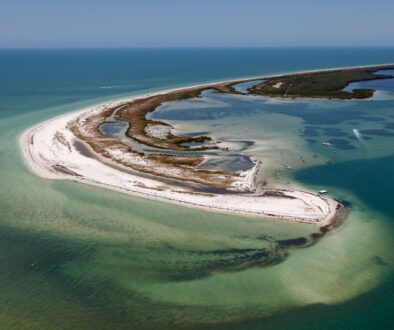
Most Popular , Vacation
Exploring Anclote Key: What Travelers Need To Know
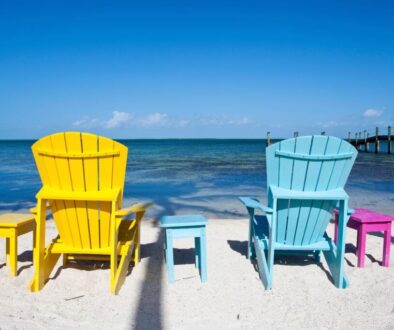
How To Make The Most Of Your Key Largo Shopping Experience
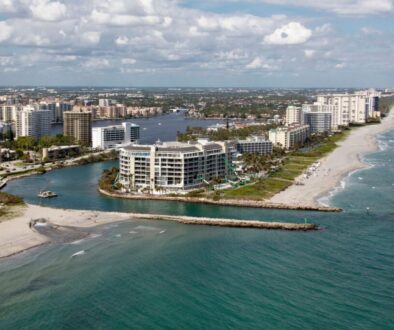
Adventure , Most Popular
Boca Raton Facts: What You Probably Didn’t Know
Find us on social media.

© SeafariYachtCharters.com 2024
View Our Privacy Policy
Website design by Correct Digital

Ridetheducks.com is reader-supported. When you buy through links on our site, we may earn an affiliate commission. Learn more
Trimaran vs Catamaran
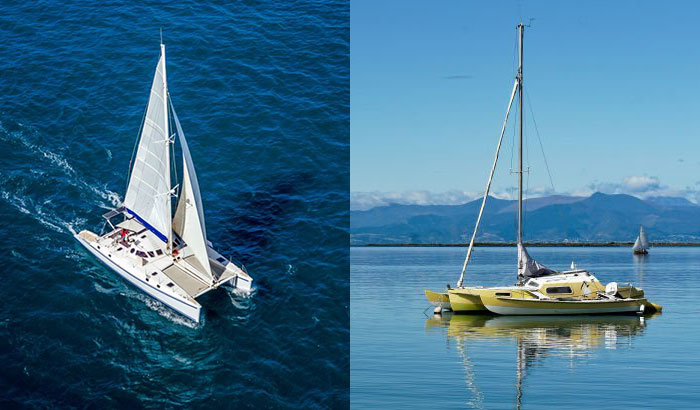
Trimaran and Cataraman are quite similar in design, making it difficult for many people to distinguish between the two, let alone choose one. However, you might be surprised to know that their differences are rather significant.
In this post, we will compare the Trimaran and Catamaran so that you can clearly identify them and make an informed decision when purchasing one.
About Trimaran boats
About catamaran boat, so, which boat do you think is better.
A Trimaran is a type of boat that has three hulls instead of the usual one. The front and back hulls are usually small and used for stability, while the middle hull is larger and used for most of the boat’s functionality.
Some Trimarans can also be configured to be sailed as a Catamaran by removing the front and/or back hulls.
Trimaran boats have several unique features that make them better suited for certain tasks than other types of boats.
- Trimarans are more stable in rough water than other boats, and they are often used for racing or long-distance sailing
- The extra hulls make Trimarans more stable and less likely to capsize in rough water
- They also provide more space inside the boat for passengers or cargo and can be faster and more maneuverable than other boats of similar size
- Trimarans are also good for sailing in shallow waters since they can float on two hulls while the third one is still submerged
Despite their advantages, Trimarans do have some drawbacks.
- They can be more difficult to dock or more than other boats, and they require more crew members to operate effectively
- They are also more expensive to build and maintain than other boats
However, for those who are looking for a fast, stable, and versatile boat, the Trimaran is a great option.
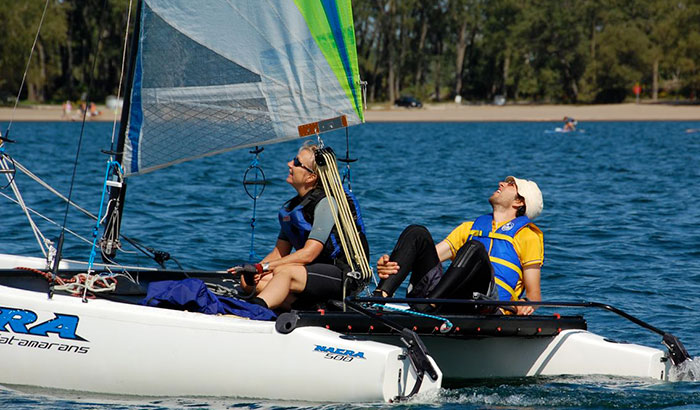
Catamaran boats are a type of boat that has two hulls, making them comfortable vessels to ride.. They can also be more comfortable to ride in than other types of boats.
Here’re some of this boat’s advantages:
- Catamaran boats can be sailed by a smaller screw than other types of boats. This also makes them a popular choice for charters and sailing vacations
- Their prices are more affordable, thus suitable for family use
- Catamarans are usually built from lightweight materials, making them ideal for speed and agility
- The most distinguishing feature of a Catamaran boat is the lack of any external rigging. This means that the sails are mounted on the mast and boom directly to the hulls, rather than to a frame that hangs below the hulls
- Therefore, they have a great range of sail shapes and sizes, which can be adapted to changing wind conditions
- Another advantage of a Catamaran boat is its stability. Because the hulls are wide and shallow, they offer more resistance to overturning than a monohull boat of the same size. This makes Catamarans an ideal choice for sailing on rough seas
However, Catamarans do have a few drawbacks.
They are less agile than monohull boats, making docking in confined places more challenging
- Docking these boats is costly
- In big waves, there is a chance of slapping
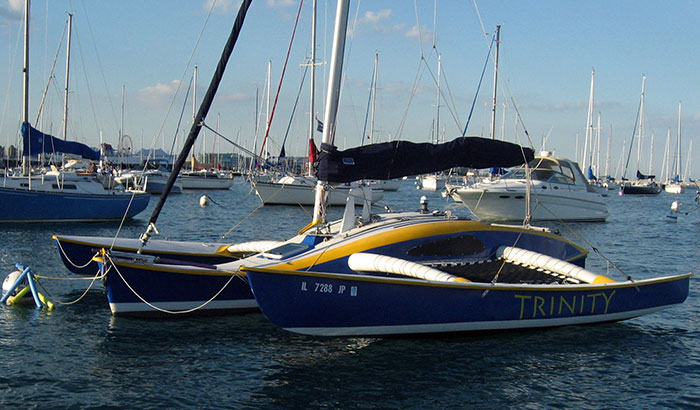
- Speed – The Trimaran is the faster of the two boats. It can reach speeds of up to forty knots, while the Catamaran can only reach about half that speed.
- Stability – The Trimaran is more stable than the Catamaran. This is because it has three hulls instead of two. This makes it less likely to capsize in rough seas.
- Space – The Catamaran is bigger than the Trimaran. This means that it can hold more people and cargo. The Catamaran can also be used for longer trips, while the Trimaran is better suited for shorter trips.
A Trimaran is a multi-hull boat with three hulls, while a Catamaran has two hulls. Both types of boats can be made from a variety of materials, including wood, aluminum, and fiberglass.
More Stable and Ideal for Racing: Trimaran
The main advantage of a Trimaran is its stability in rough waters. Catamarans are also stable boats, but they are not as resistant to strong winds and waves as Trimarans.
Trimarans also typically have more deck space than Catamarans, which makes them ideal for sailing or fishing trips.
A Trimaran is typically faster and more stable than a Catamaran, making it ideal for racing or long-distance travel. A Catamaran, on the other hand, is better at handling rough seas and is more agile.
Ideal for Calm Water: Catamaran
Catamarans are usually faster and less expensive to build than Trimarans, making them a popular choice for recreational boaters. However, due to their size, Catamarans are not as seaworthy as Trimarans and are not recommended for use in rough waters.
Trimarans and Catamarans are both types of sailing vessels . They have many similarities, but there are also some important differences between them. If you’re interested in learning more about these boats or in purchasing one for your use, it’s important to understand the pros and cons of each type.
Overall, the Trimaran is the better boat. It is faster, more stable, and has more space. However, the Catamaran is cheaper and can be used for longer trips. If you are looking for a boat that is good in all areas, the Trimaran is the best choice.
Hopefully, this article has helped you do that. Thanks for reading!
Leave a Comment Cancel Reply
Your email address will not be published. Required fields are marked *
Save my name, email, and website in this browser for the next time I comment.

Trimaran VS Catamaran – Which Boat Is Best?
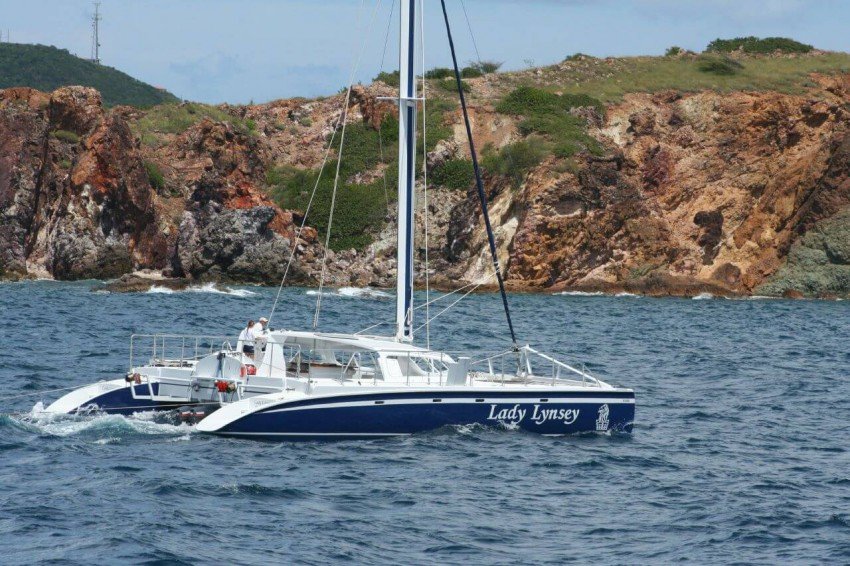
If you’re planning to buy or charter a multihull boat, you might be wondering which one is better: trimaran or catamaran. Both have their pros and cons, and the decision ultimately depends on your needs and preferences. In this article, I’ll explain the differences between these two types of vessels to help you make the best choice for your needs.
Post updated: 10 November 2023
Table of Contents
Differences Between Trimarans and Catamarans?
If you’re in the market for a new vessel or plan a family vacation on the water, you might wonder what the differences are between a catamaran and a trimaran.
Let’s see what they are:
A catamaran is a multihull vessel with two or twin hulls that are parallel to each other and fixed to a wide beam.
This design offers stability and speed, making it a popular choice for cruising long distances comfortably and even racing.
They also provide more interior space than trimarans, allowing for larger cabins and more storage.
When it comes to sailing performance, catamarans are known for their speed and agility.
Their twin hulls allow them to easily glide over the water, making them popular among boaters.
Cats are stable, fast, spacious, and super comfortable and are more stable at anchor than trimarans. However, catamarans tend to perform better in downwind conditions than in upwind conditions.
A trimaran is a multihull vessel that has three hulls. The two smaller outrigger hulls are attached to the center hull, which is larger and used for most of the boat’s functionality.
This design offers even more stability than a catamaran, making it a great choice for those who want to sail in rough waters safely.
The three-hulled design makes them super stable, and as mentioned above, they can easily handle rough waters. They also have a smaller turning radius, making them easier to maneuver in tight spaces.
Another important thing to know about Trimarans is that they provide a decent degree of livability, but they fall short of catamarans in two regards. First, they heel more than cats, making it difficult to do things like cooking on board. Second, they support much less load than catamarans.
Pros and Cons of Catamarans and Trimarans
Before making a decision whether to sail a catamaran or a trimaran, there are pros and cons you must consider. Let’s see what there are:
- Stability: Catamarans have two hulls, which makes them extremely stable. This means that you are less likely to experience seasickness or feel the boat rocking in rough waters.
- Space: Catamarans have a lot of space both inside and outside the boat. This makes them great for large groups or families who want to spend time together without feeling cramped.
- Speed: While not as fast as trimarans, catamarans are still faster than monohulls . They perform better in downwind conditions than trimarans and are great for long-distance cruising in calm waters.
- Shallow Draft: Catamarans have a shallow draft, which allows them to enter shallow waters and anchor closer to shore.
- Cost: Depending on how well the Catamaran is equipped, it can be more expensive than trimarans. Not always, though.
- Harbor Cost: As catamarans have a very large beam, this means that a berth at the marina will be higher.
- Navigation: Catamarans tend to struggle sailing close to the wind .
- Speed: Trimarans are known for being faster than cats and single-hull boats. They can easily reach high speeds and are great for racing or long-distance cruising.
- Stability: Trimarans are more stable than catamarans due to their three hulls.
- Space: Trimarans are wide, but the interior is less spacious than catamarans.
- Safety: Provide exceptional buoyancy. If a trimaran capsizes, there is almost no chance it will sink.
- Navigation: Trimarans can sail in any weather condition and perform much better upwind than cats.
- Berthing: Trimarans are more difficult to maneuver in harbors, making finding a berth in crowded marinas more challenging.
- Maneuverability: Trimarans require more ability from sailors to beach without difficulty than catamarans.
- Loading: Trimarans struggle to carry as much weight as catamarans.
- Sailing: Trimarans require more effort and work on the deck.
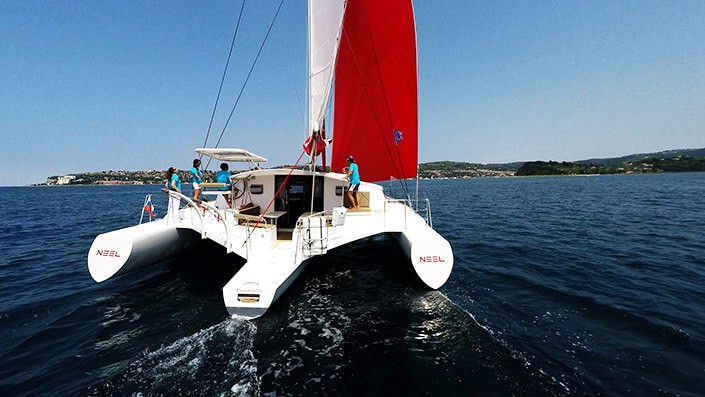
Design and Structure
When it comes to design and structure, there are significant differences between trimarans and catamarans. Below, I’ll walk you through these two multi-hull vessels’ geometry, hydrodynamics, weight, and materials.
Geometry and Hydrodynamics
One of the most significant differences between trimarans and catamarans is their geometry. A trimaran has a central hull with two outriggers connected to a large beam, while a catamaran has two parallel hulls connected by a central platform.
This twin-hull design gives catamarans a unique sense of balance and stability. On the other hand, trimarans offer superior stability and adaptability in various water conditions thanks to their three-hulled design.
The central hull of a trimaran is typically longer and narrower than the hulls of a catamaran, which leads to better hydrodynamic performance.
Both trimarans and catamarans have different hydrodynamic resistance characteristics.
For instance, trimarans have less wetted surface area, which means they experience less drag as they move through the water. This feature makes trimarans faster than catamarans in rough weather conditions and high winds.
Performance and Speed
When it comes to performance and speed, there is a clear winner between trimarans and catamarans . Trimarans are known for their speed and are often faster than catamarans of the same size and weight. This is because of their unique design, which has speed and safety qualities that provide significant advantages over catamarans.
Trimarans have less hydrodynamic resistance than catamarans due to their narrower central hull, which allows them to slice through the water more efficiently in rough seas.
While catamarans are also fast, they often fall short of trimarans in terms of speed and performance. But that’s not always true in downwind conditions because cats are light, and their sails are positioned equivalent to the wind, making them faster than tris in downwind conditions.
Heeling and Capsizing
One of the biggest concerns when it comes to stability is heeling and capsizing. Heeling means the boat leans from one side to one side, while capsizing is when the boat flips over completely.
Both trimarans and catamarans heel, but trimarans provide greater stability and are less likely to capsize due to their three hulls. However, this doesn’t mean a trimaran can’t capsize.
In rough conditions, if a wave gets higher than half the size of the beam, the boat can flip over, but because trimarans have exceptional buoyancy, they float on the surface of the water and can serve as a rescue platform, but they won’t sink!
Comfort and Space
One important factor to consider when choosing between a cat and a tri is comfort and space. So, let’s look at these two types of boat’ accommodation: storage, cockpit, and living quarters.
Accommodation and Storage
One of the main advantages of catamarans over trimarans is the amount of space they offer. Catamarans typically have larger cabins and more storage space than trimarans. This makes them a great choice for longer trips, as you’ll have plenty of room to store all your gear and personal belongings.
Trimarans, on the other hand, have smaller cabins and less storage space. This can make the passengers feel a bit cramped, especially on longer trips.
However, some trimarans do offer creative storage solutions, such as under-bunk storage compartments or overhead storage racks. Note that the latest models of trimarans are extremely spacious and offer as much comfort and space, if not more, than catamarans do.
Another difference between trimarans and catamarans is their weight. While trimarans can potentially be built lighter than some catamarans, catamarans are lighter on average due to having one fewer hull requiring structure and ballast.
The weight distribution of a trimaran is also different from a catamaran, with more weight concentrated in the central hull. This feature provides better stability and performance in rough seas and upwinds.
Catamarans, on the other hand, can support more load than trimarans. This feature makes them ideal for long-distance cruising and liveaboard lifestyles.
Frequently Asked Questions
Q: which has better resale value – trimarans or catamarans.
Resale values for both trimarans and catamarans can depend on factors such as the boat’s age, maintenance, and overall condition. Generally, catamarans have a larger market and may hold their value better due to higher demand, especially among cruisers and charter companies. However, a well-maintained trimaran can still attract buyers who value speed and performance.
Q: Which type of boat is more suitable for long-distance travel: trimaran or catamaran?
Both trimarans and catamarans are fantastic for long-distance travel. Still, catamarans are often preferred among sailors for extended cruising due to their larger living spaces and privacy on board. However, if speed is a critical factor for your journey, a trimaran might be a more attractive option.
Q: What factors should I consider when choosing between a trimaran and a catamaran?
When deciding between a trimaran and a catamaran, some key factors to consider include your intended use, performance expectations, available space, and budget.
You should ask yourself:
- What are your primary sailing goals – speed, comfort, cruising, or racing?
- How much living and storage space do you need for your crew and equipment?
- What kind of stability and performance characteristics do you value most?
- Are you willing to compromise on space or speed for the sake of your preferred multihull design?
Final Words!
So, what’s the best boat? Well, both are great. The choice between a catamaran and a trimaran will depend on your needs and personal preferences. If you are looking for a peaceful trip at a slower pace with plenty of space for the whole group, a catamaran will be your best bet. On the other hand, if you want to zip through the water and get your blood pumping, a trimaran is what you need!
Want More Tips?
Sign up to Cruising Sea newsletter to receive every two weeks the latest post straight to your inbox!
Have you sailed a catamaran or a trimaran? If so, please share your experience in the comments below.

Daniella has been passionate about travel, the sea, and nature for many years. As a child, she frequently traveled throughout the Mediterranean and continued with her journeys throughout her adult life.
Her experiences have created the desire within her to share her love for traveling with other passionate and adventurers who want to discover beautiful horizons and new cultures.
26 thoughts on “Trimaran VS Catamaran – Which Boat Is Best?”
Hey, well I’m definitely the Catamaran girl. I love my space and don’t really need the thrill of the ride as much as I value the relaxation and holiday-type feeling. What’s your personal choice? Well since I’m more the sailor’s wife than the sailor, those other problems don’t really apply to me, do they? hahahaha what’s your personal choice?
We have something in common, because I am not a fan of racing . I love comfort and space, so I would go for a Cat!
Have a great day:)
I would go for the trimaran as it’s more stable in tough conditions as I would like to explore the world, not that I want to race. Catamaran is my go to option if I just want a nice vacation boat or something I agree that that one is better if you don’t want to race. I won’t buy a boat in the near future though, I certainly have not got the money, and I live at the wrong location, not far from the sea but still, I can’t even drive (no license). Great article though and I love boats. Wondered what the difference about these 2 are and now I know.?
Hi Stephanie, Sorry for the late reply. I had a minor technical issue:) Yes, trimarans are extremely stable and are faster than catamarans. However, those beautiful boats are quite expensive and if you plan on sailing around the world, you’ll need a small crew with you to handle the boat:). I am glad this article helped you know what’s the difference between a trimaran and a catamaran. Let me know if you need more info. I am always happy to help. Thank you for the comment and I wish you a lovely day.
This is a very informative comparison of the trimaran vs. catamaran style sailboat. They look similar on the exterior to the untrained eye – but it seems like the differences are pretty dramatic. If someone was looking to charter one for a vacation – do you have a specific experience or preference for one or the other?
It will depend on your personal preferences!
What are your needs? Can you be more precise?
I personally love to sail in comfort, I also need a lot of storage, so a cat is my favorite yacht!
Have a wonderful day:)
I have sailed ON a cat but never sailed one myself. Certainly a wonderful experience unlike a single-hulled vessel that rocks and rolls with the swells. That leads me to ask: if caught in rough weather (large swells and strong winds), how reliable is the trimaran? Does either configuration have limitations in this regard?
For the same size of boat, a trimaran have higher sailing performance ,a better ability to tack and go windward. So to answer to your question, a trimaran will handle better in strong winds and will go faster! But! Bear in mind that no matter if it’s a cat, trimaran, or monohull, the safety will all depend on when the sail will be shortened and how the boat will be handled in bad weather.
I hope it helped and if you have any other question , please feel free to get in touch:)
Have a great day!
Awesome write up on the differences between the two beauties. I have learned something new here. I am more of the adventure like person and your quick analysis of the Trimaran, tells me that I probably would lead to this option when choosing between the two.I will certainly browse around your site to check out other interesting articles you have on offer.Take Care, Roopesh.
Hi Roopesh,
Thank you for the compliment and you are very welcome to stroll around my website.
Take care too and wish you an awesome day!
It’s interesting to see the different opinions shown concerning of a debate. I don’t know about these vessels but I enjoyed reading it.
To me, I’ll go for Trimaran because of the modern interiors. I mean, it’s the modern feel that I’m looking for. That’s my main, personal factor.
Still, overall, I think it’s also suffice to say that these two cannot be compared because it’s not like with like. But that’s just my opinion. Trimaran for the win anyways!
So nice to see you again on my website:)
Yes, the trimaran Neel 45 has a modern look, but not every trimaran. Also, they are much faster than catamarans, sailors usually use them more for racing and catamarans for cruising.
Thank you for the comment, I really appreciate:)
I wish you a wonderful day!
I think now the Neel have brought out the 51 the game has changed somewhat. Lots more room ,walk around bed in master room. Lare shower in main head, the inside outside Cocloon as they now call it. Heaps of space below, fantastic headroom down below in central Hull. Much more classic looking boat on the exterior. Add the speed, stability and affordability compared to similar sized Cats and there really does not appear to be any more to be said. Of course it’s just my opinion and if money was not an option i think the Gunboat 60 would be the final choice, but for around 600k the Neel 51 has definitely set the standard. Take a look https://www.youtube.com/watch?v=1-997AEXfsk
Well, that’s a beautiful trimaran you have here, effectively, this one looks much more comfortable and wider than the Neel 45! I would definitely choose the 51 over the 45! I’ve really enjoyed watching the video, and it would be interesting to write an excellent review on the 51:). I agree with you, the Gunboat is such a beautiful cat, and now it makes it even harder to choose between the two of them:) Thank you for the comment and wish you a wonderful day!
Late arrival here but after reading and watching so many negative reviews about the Neel trimarans and the Neel 45 images of one build showing their train wreck quality, there is absolutely no way you can compare a Gunboat and a Neel. You’d be better off comparing it to the Yugo automobile.
The “Sailing Yacht Ruby Rose” did a recent video review of the newer Neel 47 posted on July 18, 2019 showing very clearly that its build quality is extremely lack luster. Although it was the Neel Trimaran that gave me the sea bug, one probably couldn’t purchase a poorer quality boat at any price. It’s an awesome concept but it’s a manufacturer no individual should consider buying from. I’m hoping one of the premium Cat builders will take on the task of providing a similar concept when I’m ready with my money.
Hello Eso, The beautiful thing in life is that everyone has different taste and opinion. I am glad to have you here and thank you for sharing your experience with the readers, this will certainly be useful to many people. I wish you a fantastic day!
Yes I’ve been looking at the Neel 51, Its turning my attention some what. It would make world cruising just that little bit faster and with room and comfort. PS I like the engine room.
Hi Mercury,
Thank you for the comment! The Neel 51 is a beautiful boat. She is more spacious and comfortable than the 45 Neel, but the 65 is even better! However, the 51 is an ideal cruising trimaran to sail in comfort. She provides everything sailors have ever dreamed of such as speed, stability, space, and luxury. What more to ask for:)
Thank you again for the comment and wish you a wonderful day!
I own a Catana 47 with one owner and two guest cabins. I and my wife want four cabin boat so that We can sail with our two daughters and their family including grand children. Should I buy Catana 53, Outremer 51 or Neel 51?
Thank you for commenting!
I am not a boat seller, but I will be more than happy to answer your question. The Catana 53, Neel 51, and Outremer 51 are fantastic boats. And to be honest, I would personally buy the Neel 51 because she is extremely spacious, lightweight and more stable than any catamaran out there.If you bring children, then you would want the boat to be safe. The other boats are also great but tend to perform less well in strong winds and heavy seas than the Neel 51. So yes, the Neel 51 is unbeatable in all categories! At least to me:)
I hope it helped and, please, feel free to contact me if you need to know further information. I am always happy to assist!
Thank you again for the comment and wish you a lovely day!
It’s really a good Information. I have never been in any one of the rides but I feel personally Cat is better. Do you guys know anything similar to this other then Cat trimaran like Semi-Submersible, drone etc. as I am doing a project that will help you to ride Cat Yourself alone!. Wish me good luck and please help me achieve my goal fastly, by sharing your precious knowledge and time. thank you in advance.
Hi Mohammed,
We would like to help you, but we didn’t really understand your question, could you be more specific, please?
Thank you for the comment!
Hello Daniella, Firstly thank you very much for your kind response. I would like to have some info about the Stability equation of Catamaran and different steering Mechanisms.
You are very welcome!
Please, check out these articles, I am sure you will find all the answers to your questions: file:///C:/Users/gofri/Downloads/6962-1-10720-1-10-20130718.pdf
http://www.sailingcatamarans.com/index.php/faqs/19-sailing-and-performance-questions/109-which-steering-system-should-i-use
I hope it helped! Don’t hesitate to contact me if you need more information, I’ll be more than happy to assist!
Dear Daniela Thankyou very much for your Kind help. Could you please give some Information about the construction guidance of Catamaran. I want to construct my own for my experimental purposes. Thankyou Regards Moulasaheb Md
Hi Mohamed,
I would like to help you, but you are not in the right place for this. If you are looking for sailing holiday, then I’ll be more than happy to help!
If you want to construct your own boat, I highly recommend you to check other websites.
Thank you for the comment and wish you a great day!
Leave a Comment Cancel reply
By using this form you agree with the storage and handling of your data by this website. *

What’s the Difference Between Catamaran and Trimaran? (A Closer Look)

Are you thinking of purchasing a luxury boat but can’t decide between a catamaran or a trimaran? Understanding the similarities and differences between these two types of boats can help you make an informed decision.
In this article, we’ll take a closer look at the differences between catamarans and trimarans, including their overviews, advantages, and disadvantages.
Read on to learn everything there is to know about catamarans and trimarans!
Table of Contents
Short Answer
A catamaran is a type of boat that consists of two hulls connected by a frame.
It is generally used for recreational purposes and is known for its stability and speed.
A trimaran, on the other hand, has three hulls, connected to a central hull.
Unlike a catamaran, a trimaran has a narrower beam, which makes it faster than a catamaran.
It is usually used for racing and other high-performance activities.
Overview of Catamarans
Catamarans are a type of boat that feature two or more hulls, usually of equal size, which are positioned parallel to each other.
They are typically used for recreational activities, such as sailing or fishing, due to their stability and maneuverability.
Catamarans have become increasingly popular in recent years for a variety of reasons.
The most notable feature of catamarans is their stability.
Their design allows them to stay balanced and upright even in choppy waters, which is why they are the preferred vessel for many recreational activities.
Catamarans also have the advantage of increased speed due to their wide surface area, which allows them to cut through the water more easily.
This makes them great for recreational activities such as cruising or sailing, as they can travel faster than other boats.
Another key feature of catamarans is their maneuverability.
Catamarans are designed to be agile and responsive, allowing them to turn on a dime and navigate tight spaces.
This makes them ideal for navigating shallow waters or navigating around tight obstacles.
Additionally, catamarans are often equipped with a shallow draft, which allows them to move through shallow water without scraping the bottom.
Finally, catamarans are generally considered to be safer than other types of boats.
This is due to their increased stability, as well as their wide beam, which allows them to ride out rough waves more easily.
In addition, their shallow draft allows them to navigate shallow waters without running aground.
Overall, catamarans are an excellent choice for those looking for a recreational vessel that can provide stability, speed, and maneuverability.
They are ideal for activities such as sailing, fishing, and cruising, and their increased safety makes them an ideal choice for families.
Overview of Trimarans

Trimarans are a type of boat that features three hulls instead of two as with a catamaran.
The main hull is typically larger than the two pontoon-style outriggers, which are located on either side of the main hull.
The outriggers are usually of equal size and are connected to the main hull at the center of the boat.
This design gives trimarans greater stability in rough waters as well as increased speed owing to their larger surface area and reduced drag.
Compared to catamarans, trimarans are typically better suited for racing and other competitive activities.
The three hull design also makes them more maneuverable, allowing them to turn sharply and quickly.
These boats can also be equipped with sails for racing or recreational sailing.
While trimarans are more expensive than their catamaran counterparts, they offer greater speeds and the ability to maneuver more easily in tight spaces.
What Differentiates Catamarans and Trimarans?
When it comes to boating, two of the most popular types of vessels are catamarans and trimarans.
Both are multi-hulled boats that offer distinct advantages, but what makes them different?
The most obvious difference between catamarans and trimarans is the number of hulls.
Catamarans feature two hulls of equal size that are positioned parallel to each other.
Trimarans, on the other hand, have three hulls, with the main hull being larger than the two pontoon-style outriggers.
Another key difference between the two types of vessels is their intended use.
Catamarans are typically used for recreational activities such as sailing or fishing due to their stability and maneuverability.
Trimarans, on the other hand, are typically faster than catamarans and are used more for racing and similar competitive activities.
In addition to the number of hulls and intended use, there are also a few other key differences between catamarans and trimarans.
For instance, catamarans tend to have a wider beam than trimarans, which gives them more stability but limits their speed.
Trimarans, on the other hand, are often narrower and faster, but less stable.
Another difference is the cost.
Catamarans tend to be more expensive than trimarans due to their larger size and two hulls.
Additionally, catamarans usually require more maintenance due to the two hulls, while trimarans are typically simpler and require less maintenance.
Finally, catamarans and trimarans differ in how they handle in different weather conditions.
Catamarans are more stable in rough seas , while trimarans are better in calm waters.
However, both types of vessels are generally capable of handling a variety of conditions.
In conclusion, catamarans and trimarans are both multi-hulled boats that offer distinct advantages, but have different characteristics and uses.
Catamarans are typically used for recreational activities such as sailing or fishing, while trimarans are typically used for racing and similar competitive activities.
They also differ in their cost, size, stability, and ability to handle different weather conditions.
Ultimately, the type of boat that is best for you will depend on your needs and preferences.
Advantages of Owning a Catamaran

When it comes to owning a boat, there are many advantages of owning a catamaran.
Catamarans are typically more stable than traditional monohull boats.
This is due to their wider beam, which increases stability when compared to a single hulled vessel.
Additionally, catamarans have far less drag, making them more efficient and faster in open waters.
This makes them ideal for longer trips and allows them to travel at higher speeds.
Catamarans also feature two hulls, which provide more room for storage and amenities such as sleeping quarters and a kitchen area.
This makes them great for recreational activities such as fishing and sailing, as well as longer trips where extra space is needed for passengers and supplies.
Finally, catamarans are often more affordable than other types of boats, making them a great option for those on a budget.
Advantages of Owning a Trimaran
Trimarans offer some distinct advantages over catamarans when it comes to recreational activities or competitive racing.
Due to their three hull design, trimarans are generally faster than catamarans, and offer more stability than a monohulled boat.
The extra stability of the outriggers also allows the trimaran to handle rougher waters with ease, making them a great boat for sailing in open ocean waters.
The shallow draft of the trimaran makes them ideal for sailing in shallow areas, such as bays and estuaries.
In addition, the trimaran is very efficient when it comes to fuel consumption, as the outriggers help to reduce drag in the water.
The hulls of the trimaran are also designed to be lightweight, allowing them to reach high speeds with less effort.
Finally, the trimaran is a very versatile boat, as it can be used for a variety of activities, from recreational sailing, to racing, to fishing.
All in all, the trimaran is an excellent choice for anyone looking for a fast, efficient, and versatile boat.
Disadvantages of Owning a Catamaran

When it comes to the disadvantages of owning a catamaran, there are a few that should be taken into consideration before making a purchase.
The most notable disadvantage of owning a catamaran is the cost.
Because of their large size and complex design, catamarans are much more expensive than traditional monohulls.
Additionally, the cost of outfitting and maintaining a catamaran can be much higher than the cost of outfitting and maintaining a monohull, making it an expensive investment.
Another disadvantage of owning a catamaran is that they are not as maneuverable as monohulls, which can make them difficult to handle in tight spaces or in rough waters.
Additionally, catamarans can be more difficult to sail than monohulls, as they require more skill and experience to operate them effectively.
Finally, catamarans can be very large and bulky, which can make them difficult to store and transport.
Disadvantages of Owning a Trimaran
The main disadvantage of owning a trimaran is the cost.
Trimarans tend to be more expensive to buy than catamarans, and they also require more maintenance due to their more complex design.
Additionally, a trimaran requires more space to store, and they are also more difficult to transport than catamarans due to their larger size.
Finally, trimarans usually have less internal space than catamarans, which can limit their use for recreational activities.
In terms of performance, trimarans can be more difficult to handle in certain conditions, such as high winds or choppy waters.
They also require more skill to sail than a catamaran, and they can be more difficult to maneuver due to their larger size.
Additionally, trimarans tend to be slower than catamarans in certain conditions, so they are not ideal for long-distance cruising.
Finally, trimarans tend to be less stable than catamarans, which can make them less comfortable for leisure activities.
This can also make them more prone to capsizing in certain conditions, so sailors need to be cautious when sailing one.
Overall, trimarans have their advantages and disadvantages when compared to catamarans.
They are generally faster and more agile, but they are also more expensive and require more skill to sail.
Additionally, they tend to be less stable and have less internal space, so they may not be ideal for certain recreational activities.
Ultimately, its important for sailors to consider their individual needs when deciding between a catamaran and a trimaran.
Final Thoughts
It’s clear that both catamarans and trimarans offer unique advantages and disadvantages depending on the type of activities you plan to do.
Catamarans are great for recreational activities such as sailing and fishing due to their stability and maneuverability.
Trimarans are perfect for racing or other competitive activities, as they are faster than catamarans.
Ultimately, the decision on which type of boat to purchase depends on the type of activities you plan on doing.
Do your research, weigh the pros and cons, and make sure to consider your budget before making your final decision.
James Frami
At the age of 15, he and four other friends from his neighborhood constructed their first boat. He has been sailing for almost 30 years and has a wealth of knowledge that he wants to share with others.
Recent Posts
Does Your Boat License Expire? Here's What You Need to Know
Are you a boat owner looking to stay up-to-date on your license requirements? If so, youve come to the right place! In this article, well cover everything you need to know about boat license...
How to Put Skins on Your Boat in Sea of Thieves? (Complete Guide)
There is a unique sense of pride and accomplishment when you show off a boat you customized to your exact specifications. With Sea of Thieves, you can customize your boat to make it look like your...
Your source for the latest news on yachts, boats and more. Read through our articles to find out how to compare boats and find the right fit for you!
Trimaran vs catamaran: Which one to go for
Nov 27, 2020
less than a min
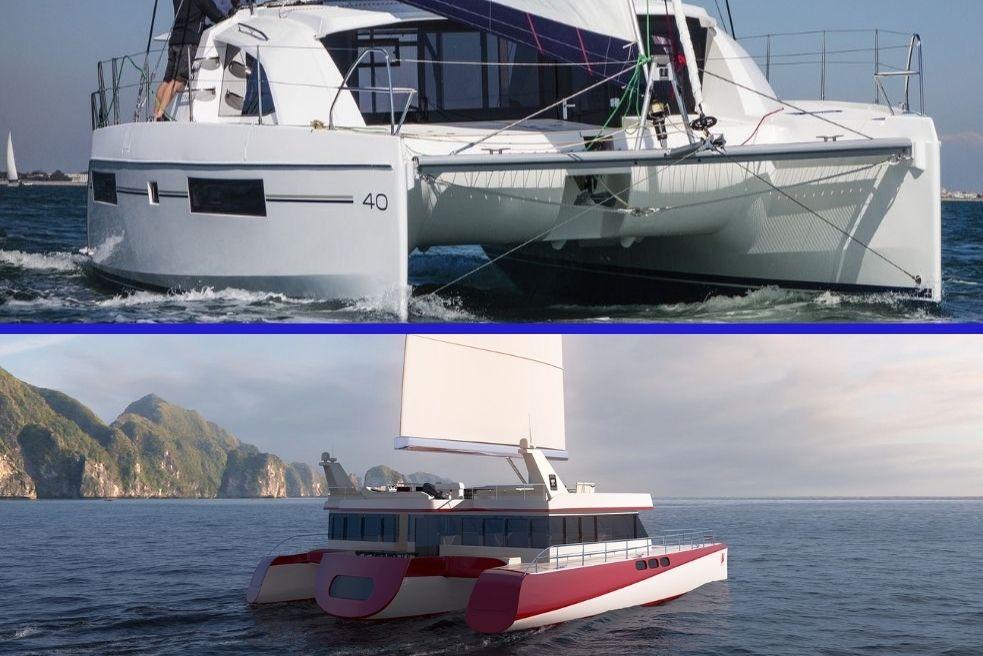
There is a lot of commotion in the marine world when it comes to the discussion of trimaran vs catamaran. Both vessels are part of the multihull category . A catamaran is a yacht with two hulls while a trimaran has three hulls.
First of all, it is important to note that both trimarans and catamarans are more popular than monohulls lately as they are easier to control. In addition, monohulls can capsize more easily in difficult weather conditions, and sometimes, they even have space limitations. Moreover, speed is a big advantage of trimarans and catamarans. Typically, these multihulls are 25-30% faster than a monohull of the same size.
Trimarans vs catamarans: which one is better
Both trimarans and catamarans have their advantages and disadvantages which means that picking one over the other is not only hard but probably impossible. The choice is based not solely on their properties but also on weather conditions, destination route, and most importantly, personal taste.
Let’s have a look at both yachts in more detail.
Catamarans are very interesting boats. They are also known as cats, an abbreviation of their name but also a tribute to their versatility. These boats are fun to sail and also provide a good level of comfort. Their size varies between a few cabins that can accommodate 2 people, to a large group of 20. While many catamarans are affordable and family-friendly, some of them also display extra luxury and can sail to the most beautiful and expensive destinations around the Mediterranean and the Caribbean. Last but not least, catamarans are very good yachts when it comes to stability, but they are mainly designed to sail in shallow waters, lagoons, or calm sea gulfs.
Trimarans have three hulls – the main one, and two overhangs. As a result of this geometry, trimarans are unsinkable. They do not capsize even in the worst of storms, and even in the rare case that they flip over, trimarans manage to stay afloat. The big disadvantage a trimaran has is that it combines the comfort and sailing capacity of a monohull boat with the security to stay afloat that a multihull provides. In addition, trimarans are some of the fastest boats out there. They can be used as chartered vessels as well as racing boats.
Trimaran vs. catamaran: which one to choose
A catamaran is a better choice if you are looking for minimal work on deck . Also, catamarans are perfect for holding events and parties on board while still maintaining their stability on the water. Here is a list of the best catamarans under 50 feet .
If you are looking for something more challenging where to practice your sailing skills, then a trimaran is a more appropriate boat for you. In addition, if you are a speed junkie, look out for the fastest trimaran boats and pick the one that best suits your needs.
While making a choice between a trimaran vs a catamaran seems easy on paper, it is harder when you are in front of the fact, or better yet, in front of the boat. To make a more informed decision, compare any boat you are looking at TheBoatDB . Find out all their features and get a better picture of what life would be like if you purchased that vessel.
You might like these too

Sailboat or Motorboat – Learn the pros and cons lg ...
Aug 24, 2022

Types of Catamaran Boats: Sailing, Power, and Luxury Catamarans lg ...
Feb 10, 2023

Which is better a wooden boat or fiberglass boat lg ...

What are the main types of sail rigs for sailboats lg ...

Which is the Best Economical Catamaran lg ...
Oct 04, 2021

What is a Chine on a Boat lg ...
Oct 01, 2021

16 Best Trimarans For Sailing Around The World (And a Few For Daysailing)
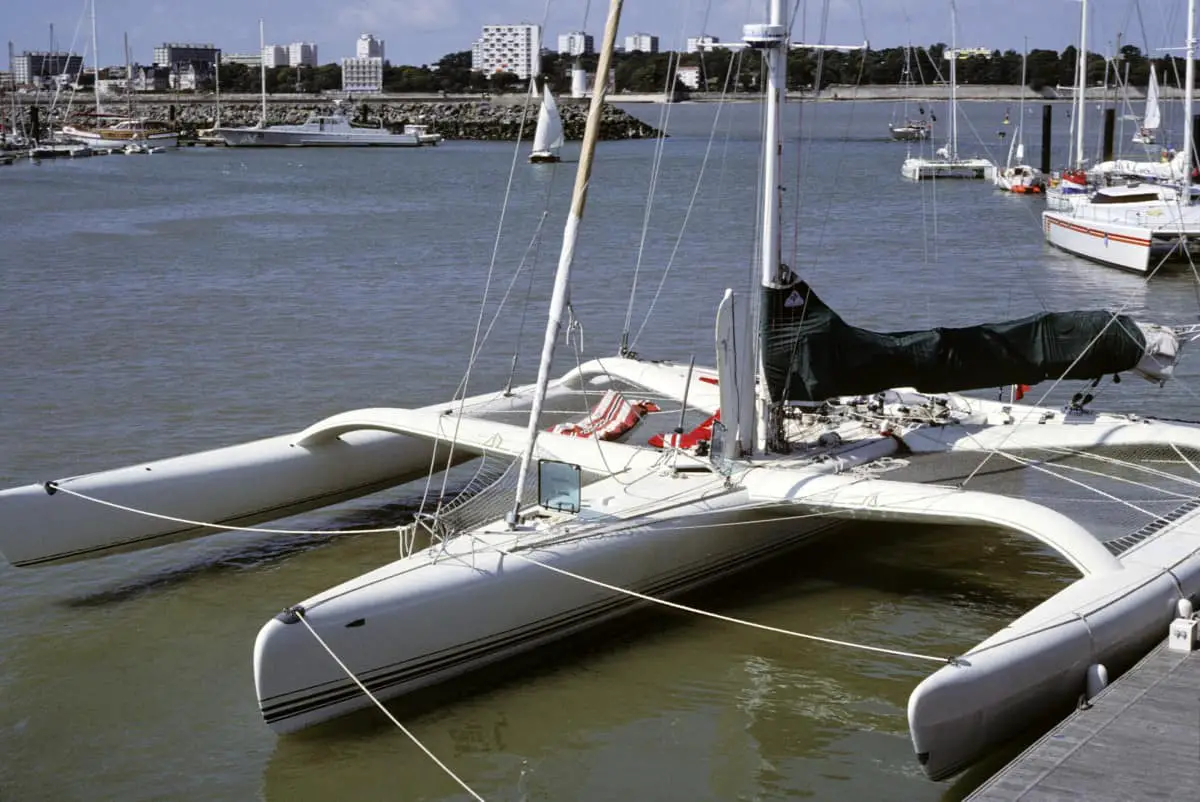
As an Amazon Associate, we earn from qualifying purchases. We may also earn commissions if you purchase products from other retailers after clicking on a link from our site.
Trimarans are growing in popularity worldwide, due to their light construction and high stability these multihulls are even faster than catamarans. Trimarans are still one of the lesser-known boat types so in this article ill be checking out some of the most popular models.
The best trimarans include:
- The Neel 43
- The Neel 47
- Dragonfly 28
- The Pulse 600
- Corsair 37
These tris are built with your safety in mind while also packing powerful speed and a wide array of comfort features to optimize your sailing experience , some are even foldable making them possible to load on a trailer and transport to the sailing destination of your choosing.
In this article, I have created a list of the 16 best trimarans in the market and their unique features. You’ll also learn the best options for different purposes such as circumnavigation, weekend sailing, racing, and more.
Table of Contents
What Is a Trimaran?

A trimaran is a multi hulled sailboat with three individual hulls; the main hull ( vaka ) and a pair of outrigger hulls ( amas ). These smaller outrigger hulls are attached to the main hull using beams.
While trimarans have a rich history dating back nearly four millennia, these types of sailboats have only gained popularity in the late 1900s and early 2000s.
Trimarans are primarily used as personal boats for sailing enthusiasts or racing. These sailboats draw their versatility from their lightweight design, making them faster and easier to handle at sea when compared to single-hulled boats (monohulls). Additionally, the three hulls also contribute to better stability, making it very hard to capsize (although more likely than a cat according to this study)
Trimarans come in various sizes, and some can be as small as 19 feet (5.8 meters) in length, while others go up to 60 feet (18meters). They’re also used for different purposes. Most trimarans are used for racing and recreational purposes, although some units are still used as ferries.
As with all things, to find out which is the best we need to understand what it will be used for. There is a big difference in requirements between a boat used for day sailing compared to offshore around the world sailing.
The list below highlights the best trimarans for different purposes.
Best Trimarans For Cruising, Liveaboard and Sailing Around The World
The Neel 43 is a French trimaran best suited for cruising. Its key features include:
- Easy maneuverability on the open sea by only a small number of crew members
This unit is also built for comfort, ideal for more extended travels. This 43-feet (13-meter) trimaran is also made with recyclable and bio-sourced materials, highlighting the manufacturer’s commitment to environmental consciousness.
This trimaran has a base price of €329,000 excluding VAT. This translates to approximately $370,138.
2.Neel 47 Possibly The Best
Named the best full-size multihull for 2020, the Neel 47 is a strong contender for one of the best trimarans in the market. This 47-foot (14.3-meter) long trimaran features optimized exterior and interior ergonomics for a unique design and look.
Still on design, the Neel 47 is ideal for couples looking to take a weekend off or spend some time as liveaboard. It has a spacious owner’s cabin and two bedrooms. It also features a spacious living room and kitchen and is optimized to ensure comfort for a couple.
The Neel 47 also has two basic guest cabins so your friends or children can tag along on your sailing adventure. Accordingly, this unit is ideal for those looking to explore the sea for the sheer joy of sailing.
The Neel 47 comes at a 571,139 euro ( $643,600 ) price tag, excluding VAT.
3. Rapido 60 The Fast and Comfortable Circumnavigator
The Rapido 60 offers a blend of performance, safety, and luxury, making it one of the best options for bluewater sailing. Measuring 59.3 feet (18 meters) in length, the Rapido 60 is an imposing unit. It’s made from lightweight sandwiches and carbon materials that provide speed and strength, allowing it to stand up to strong ocean currents.
The Rapido 60 also has spacious living spaces and is built for comfort at all points of the sail. Its design also optimizes safety. While it’s an ideal option for circumnavigating, it’s also an excellent choice for racing due to its speed.
This is also the same boat that The Youtube channel La Vagabond just purchased.
The Rapido 60 retails at $1,400,000 .
4. Rapido 40
The Rapido 40 measures 39.4 feet (12 meters) in length and is ideal for cruising around the world. The Rapido 40 features twin “C” foils, which provide added lift, enhancing its speed and performance whether you are sailing downwind or upwind.
Because it has C foils, this trimaran doesn’t have a central daggerboard, increasing interior space. Accordingly, it’s an excellent option for couples looking to cruise and enjoy great performances .
The Rapido 40 is made from high-tech all-carbon materials for a lightweight yet sturdy design. This material is also used for the countertops and furniture, and the cork flooring adds a touch of style.
This trimaran retails for $595,000 , making it a cheaper option than the Rapido 60.
5. Dragonfly 40
The Dragonfly 40 measures 40 feet (12 meters) in length. It features high-comfort standards, making it one of the best trimarans in the market for taking your family for a cruise. Because of its larger size, it has a better capacity, being capable of accommodating six to eight people, so you can bring your family and friends along.
It’s easy to navigate and extremely safe. With a maximum speed of 24 knots (44.5 km/h), this trimaran also provides fast speeds to make your cruise even more exhilarating.
The Dragonfly 40 retails from €509,000 exclusive of VAT, which rounds up to $572,000 .
6. Dragonfly 32
The Dragonfly 32 is a high-performance cruiser. Like the Dragonfly 28, this unit features a contemporary design for racing. This trimaran can accommodate five to seven crew members.
Although slightly longer than the Dragonfly 28 with its 32-foot (9.8-meter) length, the Dragonfly 32 has a max speed of 23+ knots (42.6+ km/h), making it one of the fastest trimarans for racing. This unit also has comfortable accommodation, which makes it an ideal option for a weekend cruise with family and friends.
The Dragonfly 32 has a base price of $350,000 .
7. Corsair 37
Thanks to a variable draft with a retractable rudder, the Corsair 37 is an ideal choice for shallow water exploration. This 37-foot (11.3-meter) long trimaran features advanced foam-cored construction designed for safety, making it virtually unsinkable.
The carbon hulls minimize weight, this makes for a lightweight ocean exploration sailboat with blistering speeds. One of its selling points is that this trimaran has previously been used for Arctic expeditions, possibly marking it as one of the better options for circumnavigation and offshore sailing in the northern waters.
This trimaran has a base price of $189,000 but can go up to $204,125 .
Best Trimarans For Day/Weekend Sailing
8. dragonfly 28.
The Dragonfly 28 is a 28-feet (8.75-meter) long sailboat that can accommodate up to five people. It comes in two versions:
- Touring version: This version is ideal for families.
- Performance version: This is built to provide optimal performance for the sports enthusiast within you.
It clocks a maximum speed of 22+ knots (22+ km/h) and is beam-folded. It’s an excellent option if you want a high-performance, comfortable yet smaller unit for your day or weekend cruise.
The Dragonfly 28 starts at €188,280 inclusive of VAT, which comes to around $211,600.
9. Dragonfly 25
Like other trimarans under the Dragonfly brand, this 25-foot (7.62-meter) trimaran is great for both racing and short term cruising. However, this high-performance boat delivers easy handling, making it perfect for couples looking to take a ride out over the weekend and seasoned sailors looking for an exhilarating racing adventure.
The Touring version features a lightweight build and offers comfort and accommodation to keep you, and the few guests you can fit, comfortable during the ride. This trimaran also has a Sport version, which is optimized for racing.
The Dragonfly 25 retails from EUR 86,800 .
10. Pulse 600
The Pulse 600 trimaran is a compact sailboat. It’s made from lightweight, carbon-reinforced construction and vacuum-formed materials for optimal speed. This trimaran is an ideal option if you are looking for speed.
It also features ample deck space, greater stability, and volume than most trimarans of similar size and build.
This trimaran measures 19.8 feet (6 meters) in length and can be sailed single-handedly by one person with minimal effort. The Pulse 600 has a base price of $38,800 , which places it in the lower price range.
The F-22 is one of the smaller trimarans in the market. Developed in New Zealand, the F-22 is a folding trimaran built for speed. The hulls are made from narrow fiberglass tied together using fiberglass beams and aluminum, minimizing bulk while optimizing speed.
The F-22 is roomy and is not as pricey as other models in the market. This trimaran has two main versions:
12. 2019 Weta Trimaran
The 2019 Weta trimaran is a 14.5-foot (4.4-meter) trimaran featuring a carbon frame, centerboard, rudder foil, and rudder shock. The hull is made from fiberglass and foam. The Weta is built for strength and speed based on these lightweight materials.
The 2019 Weta trimaran is easy to sail and is worth considering whether you want to take a quiet sail, race with your friends, or take kids to a sailing lesson. It has a simple design and is easy to set up independently. Thanks to its collapsible design, this trimaran is easily stored away with minimal space demands.
13. WindRider 17
The 17.4-foot (5.3-meter) WindRider 17 is one of the more versatile trimarans in the market. It packs high performance for a low cost. This trimaran has a light rotating mast to boost performance, and a full-battened mainsail optimizes visibility.
This sailboat is made from rotomolded polyethylene, which is more durable than fiberglass and demands less maintenance.
The WindRider 17 has a comfortable interior and can fit six adults. This is an ideal choice for social sailing for a couple or a family and friends. It’s easy to ride, and a shallow draft allows easy maneuverability.
14. Astus 22.5
If you’re looking for something small but still comfortable, this 22.5-foot trimaran is for you. Built for speed and maneuverability, the Astus 22.5 has optional foils to optimize speed. The modern design, coupled with the spacious interior, can fit up to four beds. Accordingly, this trimaran is suited for family outings.
This trimaran also has a foldable design, collapsing to only 16 feet (4.9 meters) for easy storage.
15. Multi 23 Trimaran
The Multi 23 trimaran has a contemporary design, featuring a vinyl ester and PVC foam core construction. The section below the waterline is made of solid glass for a sturdy base.
The beams are made of lightweight carbon, and the trimaran features a 33-foot (10-meter) aluminum rotating wing mast for optimal harnessing of the wind. While ideal for weekend excursions with family, once rigged with the asymmetrical spinnaker will get your heart pumping.
This trimaran packs high performance at a lower cost than most other options in the market. It’s a good choice if you are looking for a high-performing unit without spending an arm and a leg.
16. Challenger Class Trimaran
The Challenger Trimaran 15 is the best choice for persons with disabilities. It’s designed to provide disabled sailors an opportunity to explore their passion for sailing without worrying about aspects like safety or operation.
A man named Geoff Hold circumnavigated the British Isles in 2007, becoming the first disabled person to achieve this feat. He had quadriplegia.
Living up to its name, the Challenger can withstand harsh weather conditions while blending performance with speed.
Final Thoughts
Admittedly, no trimaran is best for everyone. But whether you are looking to race with your friends, take your loved ones or friends for a cruise over the weekend, or circumnavigate the ocean, you can rest assured that these lightweight trimarans will deliver speed, safety, and comfort to make it worth your while.
These brands are innovatively designed and feature intricate safety mechanisms that make them virtually unsinkable. Give them a shot and begin your ocean adventure.
- Basco Boating: A Comprehensive Guide & Introduction to Trimaran Yachts
- TheBoatAPP: New Trumarans: Which are the Best Ones
- Corsair Marine: Corsair 37
- Dragonfly: Dragonfly 28
- Rapido Trimarans: Rapido 60
- Neel Trimarans: Neel 43
- Yachting World: World’s Collect Yachts: Maxi Trimaran MACIF
- Yachting Monthly: Dragonfly 28 Performance
- Rapido Trimarans: Rapido 40
- Dragonfly: Dragon 32
- Dragonfly: Dragonfly 40
- Yachting World: Dragonfly 40 yacht tour: This cruising trimaran can do 24 knots
- Dragonfly: Dragonfly 25
- NauticExpo: Dragonfly 25
- Yachtworld: Corsair 37 boats for sale
- Cruising World: Neel 47 Trimaran: Best Full-Size Multihull0
- Neel Trimaran: Neel 47
- Multihull Solutions: NEEL 47 Boat Review | Cruising World
- Yacht World: 2022 Neel 47 for sale
- Farrier International: F-22
- Weta Marine: The Boat
- WindRider: WindRider 17 Trimaran Sailboat
- Astus Boats: Astus 22.5
- Boat-specs: Multi 23
- National Maritime Museum Cornwall: Challenger Trimaran #1 – BC26
Owner of CatamaranFreedom.com. A minimalist that has lived in a caravan in Sweden, 35ft Monohull in the Bahamas, and right now in his self-built Van. He just started the next adventure, to circumnavigate the world on a Catamaran!
Leave a Reply Cancel reply
Your email address will not be published. Required fields are marked *
Save my name and email in this browser for the next time I comment.
Recent Posts
Must-Have Boat Gear for Catamaran Sailors!
Sailing is probably the most gear-intensive activity I've ever done; there are so many decisions to be made about what gear to buy now, for tomorrow, and what to definitely never buy. The gear on...
6 Best Trailerable Trimarans For Bluewater and Coastal Sailing
Having a boat costs a lot of money, even when you are not using it, marina fees, etc. And once it is in the water most sailors never go very far from their "home marina" and sailing will be somewhat...

IMAGES
VIDEO
COMMENTS
In addition, trimarans are much more stable than the alternative. The three hulls provide extra balance and lower resistance because even if there are three hulls in a trimaran, they are smaller and narrower. Lower resistance also leads to lower fuel consumption. Trimarans are very comfortable to sail in as the main hull is stabilized by the ...
The trimaran offers major advantages for damage survival. The side amas provide excellent protection to the center hull, which military designers find especially useful. But the cross deck also helps with damage survival by containing massive reserve buoyancy. Imagine a damage situation where the ship sinks down to its cross deck.
A trimaran is distinguished by three characteristics: Speed, Stability and lightness. Speed increases navigational distances. The faster we go, the farther we go. By lengthening the stride, by offering speeds well in excess of a monohull, the trimaran enables you to envisage more distant stages. A trimaran is stable, she doesn't heel.
The advantages of trimarans vs. catamarans mainly come down to speed. Trimarans are among the speediest boats available, offering lightning-fast speeds on open waters. Many recent winners of notable boating competitions have been won by boaters piloting trimarans. These boats also perform well when heading upwind and are remarkably stable with ...
Terminology. The word "trimaran" is a portmanteau of "tri" and "(cata)maran", a term that is thought to have been coined by Victor Tchetchet, a pioneering, Ukrainian-born modern multihull designer. Trimarans consist of a main hull connected to outrigger floats on either side by a crossbeam, wing, or other form of superstructure—the traditional Polynesian terms for the hull, each float and ...
Explore the unique characteristics of the three-hulled trimaran sailboat, and learn about its advantages and disadvantages compared to other sailboat types.
Gabriel Hannon. August 30, 2022. As boatbuilders make faster and more luxurious multi-hulls for cruising and racing, it is time to settle the debate: Catamarans vs. Trimarans. Catamarans and trimarans have distinct characteristics regarding comfort, sailing performance, safety, and personal preference. The dual- or tri-hull designs both confer ...
Today there are both power and sailing trimarans, though the vast majority of the trimarans on the market are sailboats. Having three hulls spaced out apart from one another nets many of the same advantages as catamarans enjoy: reduced wave impact, increased stability, and increased deck space since the bow doesn't come to a point at the end ...
There are several advantages to trimarans over monohulls: They are faster - Trimarans are typically 20-30% faster than equivalent monohulls, making them ideal for racing or long-distance cruising. They are more stable - The wider beam (width) of a trimaran makes it much more stable than a monohull of similar length. This is especially ...
Trimaran yacht advantages over monohull yachts. When compared to single-hulled yachts, trimarans no doubt have some advantages. Some feature differences also exist. A trimaran, when compared with a monohull of the same length would have a shallower draft. It would also have a wider beam and a less wetted area.
A Trimaran has three hulls spaced out apart from one another which nets many of the same advantages as catamarans enjoy, with some additional benefits. Explore ... Having three hulls spaced out apart from one another nets many of the same advantages as catamarans enjoy: reduced wave impact, increased stability, and increased deck space since ...
Stability. A trimaran uses buoyancy in one of it's two amas to keep the boat sailing level, in contrast to a monohull which uses ballast in its keel. The result of using positive buoyancy and a wide beam is an incredibly level sail. You can comfortably sit around the cockpit, out on the ama or lounge around on the nets, the available deck ...
Trimaran sail trim. One of the biggest differences between a cruising monohull and a multihull is how the mainsail is trimmed. Leech tension on a yacht is often largely controlled by the kicker and the backstay, while the mainsheet sheets the mainsail in and out, predominantly controlling the angle of the boom to the centreline, and there may be a short traveller.
Pros and cons of Trimarans. Let's look at the advantages and disadvantages of trimaran sailboats. Pros. Trimarans are very fast, typically faster than both cruising and racing catamarans. They can sail in nearly any wind conditions. Trimarans are extra stable and hard to flip over. The heeling allows you to understand when it's time to reef
Trimarans tend to be more performance oriented than catamarans. In part, this is because it's easier to design a folding trimaran, and as a result Farrier, Corsair, and Dragonfly trimarans had a disproportionate share of the market. ... Farrier saw clear advantages of the new bow form. The F-22 is a little faster, but more importantly, it is ...
Trimarans, like catamarans, are multi-hulled watercraft. As the name implies, they have a second hull compared to catamarans. The trimaran's three hulls make it entirely unsinkable. ... Thus, they combine the advantages of a monohull with the stability of a catamaran, effectively combining the best of both worlds. ...
Trimaran vs Catamaran. They are less agile than monohull boats, making docking in confined places more challenging. Speed - The Trimaran is the faster of the two boats. It can reach speeds of up to forty knots, while the Catamaran can only reach about half that speed. Stability - The Trimaran is more stable than the Catamaran.
Speed: Trimarans are known for being faster than cats and single-hull boats. They can easily reach high speeds and are great for racing or long-distance cruising. Stability: Trimarans are more stable than catamarans due to their three hulls. Space: Trimarans are wide, but the interior is less spacious than catamarans.
Advantages of Owning a Trimaran. Trimarans offer some distinct advantages over catamarans when it comes to recreational activities or competitive racing. Due to their three hull design, trimarans are generally faster than catamarans, and offer more stability than a monohulled boat.
Moreover, speed is a big advantage of trimarans and catamarans. Typically, these multihulls are 25-30% faster than a monohull of the same size. Trimarans vs catamarans: which one is better. Both trimarans and catamarans have their advantages and disadvantages which means that picking one over the other is not only hard but probably impossible.
While trimarans do provide a decent degree of livability, they fall short of catamarans in two regards. First, they heel more than cats, making it difficult to do things like cooking on board. Second, they support much less load than catamarans. To put things into perspective, some 45 feet (14 meters).
This trimaran retails for $595,000, making it a cheaper option than the Rapido 60. 5. Dragonfly 40. The Dragonfly 40 measures 40 feet (12 meters) in length. It features high-comfort standards, making it one of the best trimarans in the market for taking your family for a cruise.
WHY A. CORSAIR. Benefits of a Trimaran Corsair's are always launched folded, requiring no more ramp space than a monohull. Once afloat, stability is excellent. They can even be motored while folded and will fit nicely into any standard width marina space. Many converted monohull sailors are now passionate advocates of two hulls over one.